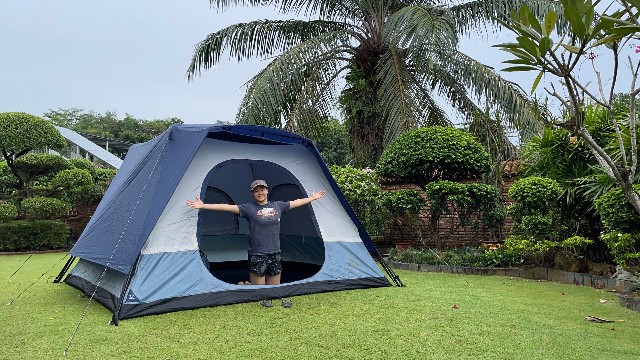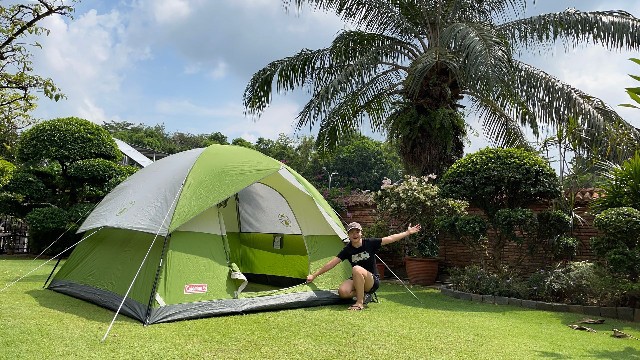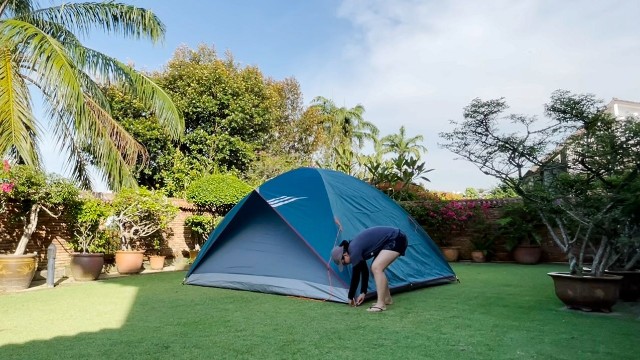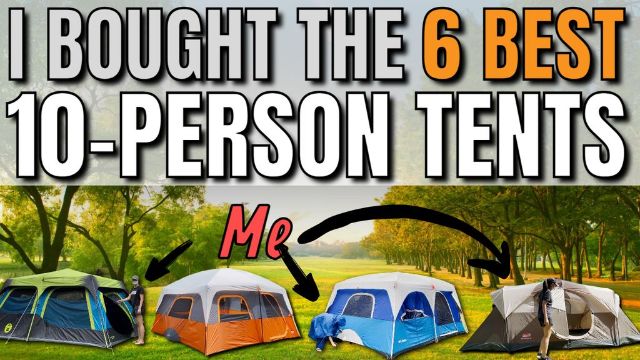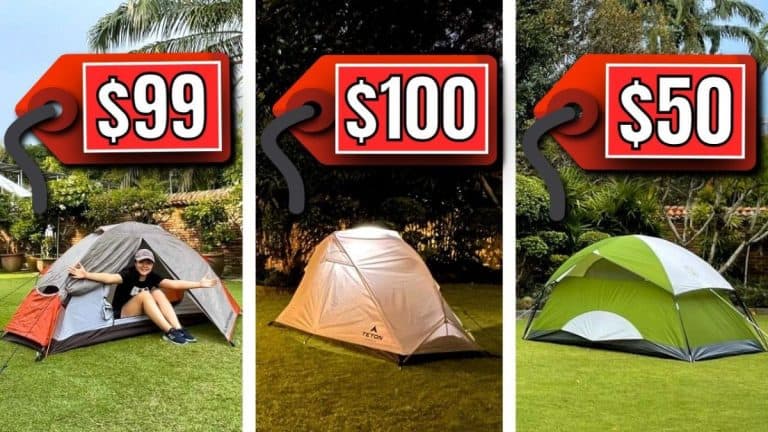The 7 BEST 6-Person Tents 2025 (I Bought & Tested Them All!)
This page contains affiliate links, and that means that I may earn a commission if you buy something, at no extra cost to you. You can find my full disclosure policy here.
For this review, I bought and tested these 7 BEST 6-person tents:
- The North Face Wawona 6;
- REI Base Camp 6;
- REI Wonderland 6;
- Caddis Rapid 6;
- Eureka Copper Canyon LX 6;
- Coleman Sundome 6; and
- NTK Cherokee 6.

Quick Summary
Here’s a summary of all the 6-person tents that I recommend (after buying and testing, of course):
| 6-Person Tent | Recommendation | Score | Price |
|---|---|---|---|
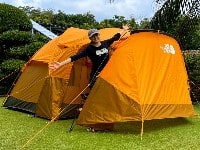 |
BEST OVERALL The North Face Wawona 6
|
||
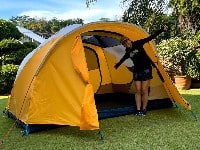 |
RUNNER UP PICK REI Co-op Base Camp 6
|
||
 |
BEST CABIN TENT REI Co-op Wonderland 6
|
||
 |
FASTEST SET UP Caddis Rapid 6
|
||
 |
HIGHEST PEAK HEIGHT Eureka Copper Canyon LX 6
|
||
 |
BEST BUDGET PICK Coleman Sundome 6
|
If you enjoyed the video, please consider subscribing to my YouTube channel right here:
I spent more than $2,000 buying these 6-person tents (yes, I actually buy all my tents with my own savings!), and a good 6 months testing all of them, not including the time it took to put together this series of articles and YouTube videos.
And without further ado, let’s get into the more detailed recommendations.
- Quick Summary
- 1. The North Face Wawona 6 (Best Overall)
- 2. REI Co-op Base Camp 6 (Runner Up Pick)
- 3. REI Co-op Wonderland 6 (Best Cabin Tent)
- 4. Caddis Rapid 6 (Fastest Set Up)
- 5. Eureka Copper Canyon LX 6 (Highest Peak Height)
- 6. Coleman Sundome 6 (Best Budget Pick)
- 7. NTK Cherokee 6 (Alternative Budget Pick)
- Recommendation Summary
- How I Tested My 6-Person Tents
- Why You Can Trust Me
- Conclusion
1. The North Face Wawona 6 (Best Overall)
Key Info
- Peak height: 77 inches
- Length: 9 feet 8 inches
- Width: 7 feet 10 inches
- Tent base area: 75.7 square feet
- Length (vestibule): 8 feet 3 inches (*longest length)
- Width (vestibule): 7 feet (*longest width)
- Vestibule area: 51.0 square feet
- Materials: 150D polyester (flooring), 75D polyester (tent body), DAC MX (poles), SBS (zippers)
- Packed size: 26 x 16 x 10 inches
- Weight: 19.4lbs.
- Storage: 9 pockets, 8 lantern loops
- Ventilation: 4 vents, 3 windows, 2 tent doors, 2 vestibule doors, ceiling mesh
- Set Up Timing (1P): 20 minutes
- Take Down Timing (1P): 14 minutes
Pros and Cons
Summary
The North Face Wawona 6 is easily my top pick, because it not only has the best overall score, but it’s also my best all-rounder tent.
Check out how I scored each of these 6-person tents in all the different tests:

Notice how the Wawona has a ‘yellow’ in just 1 test? It’s great at almost everything. On the other hand, all my other tents have ‘yellows’ in at least 2, some 3, some 4, and some even 5 different tests.
This tent also scored better than all the other tents in not just quality, but also for rain and wind protection. Here’s why.
I put my Wawona through the heaviest rain test of all my other tents. After 3 hours of this non-stop super heavy rain, the Wawona was completely dry.
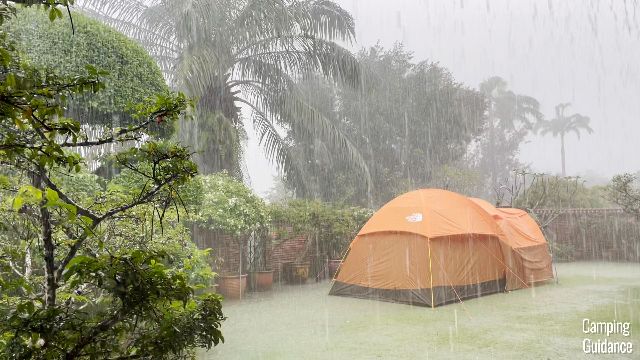
On top of that, you don’t have to seal any of the seams. Every single seam is perfectly taped.
I was lucky enough to test this as well. Because it rained so heavily, my entire yard was flooded, and the bottom of my Wawona, especially this corner here, was sitting in 2 inches of water.
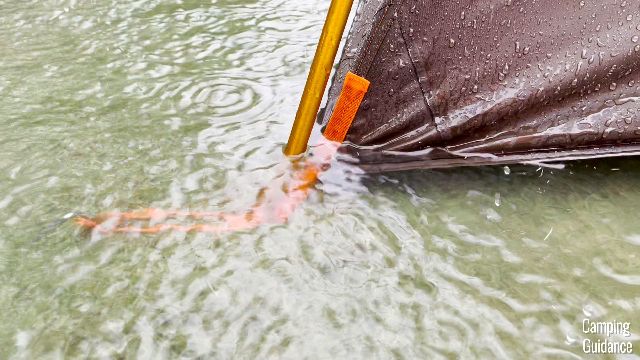
After the rain stopped, I checked the seams at this corner, and there wasn’t any leaking into the tent. It was completely dry. How amazing is that?
Also, the Wawona 6 has the most awesome vestibule, which is super useful for storing wet gear.
The tallest height inside the Wawona’s single vestibule is about 74 inches, while the shortest height at the other end is still a whopping 65 inches. So, I could stand upright throughout the entire vestibule. (I’m 5’3.)

In fact, I could fit 2 camping chairs and still have plenty of leftover space for a big camping table. Easily the most spacious vestibule of all the tents here.
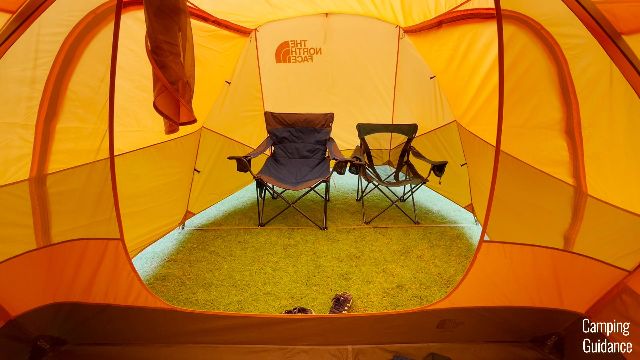
When it comes to wind protection, the Wawona’s poles are the best-equipped. It comes with top-of-the-line DAC MX poles, which are much stronger and sturdier than all the other tent poles in this list.
In the 3 weeks that I spent testing my Wawona 6, through crazy rains and some winds, none of my poles bent at all, even in the slightest.
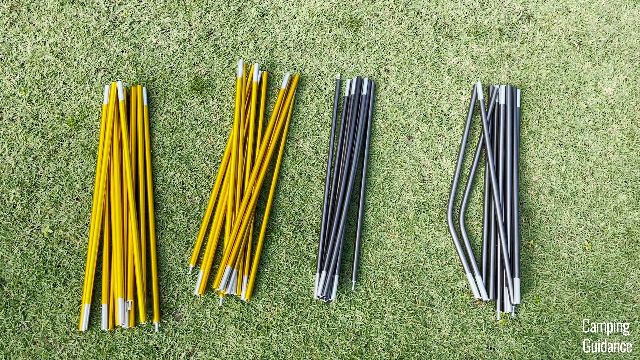
The Wawona also has quite a bit of mesh, plus a whopping 4 doors, 2 in the vestibule, and 2 in the inner tent, for a ton of cross-ventilation.
Honestly, rain or shine, for camping in the summer, The North Face Wawona 6 is probably your best bet.

But just bear in mind that the inner tent base area (excluding the vestibule) is a little small. It is, in fact, the smallest base area of all the tents on this list. So, I would recommend a maximum of 3-4 adults in the tent, definitely not 6.
Also, the first time I set this tent up, this last corner was ridiculously difficult for me to set up. It took me ~30 minutes, no joke. Thankfully, after the first use, it got so much easier to set up. So, I recommend breaking this tent in your yard before going camping.

More info on The North Face Wawona 6:
2. REI Co-op Base Camp 6 (Runner Up Pick)
Key Info
- Peak height: 73 inches
- Length: 9 feet 1 inch
- Width: 9 feet 1 inch
- Tent base area: 82.5 square feet
- Front vestibule area: 31.1 square feet
- Back vestibule area: 21.3 square feet
- Total vestibule area: 52.4 square feet
- Materials: 150D polyester (flooring), 75D polyester (tent body), aluminum (poles), YKK (door zippers only)
- Packed size: 28 x 13 x 9.5 inches
- Weight: 20.6lbs.
- Storage: 14 pockets, 20 loops
- Ventilation: 4 vents, 2 tent doors, 2 vestibule doors, 2 windows, ceiling mesh
- Set Up Timing (1P): 17.5 minutes
- Take Down Timing (1P): 15 minutes
Pros and Cons
Summary
After the Wawona, my runner up pick has got to be the REI Co-op Base Camp 6. It has the second best score, and it performed almost as well as the Wawona for all the 7 different categories.
Here’s how to decide between these 2 tents – While the Wawona is more of a 3 season tent, for camping in summer, the Base Camp is more of a 3+ season tent, for camping in the shoulder season.
In fact, the Base Camp is the only 3+ season tent on this list, and it’s a pretty good pick at that. Here’s why.
First, the Base Camp is the only tent on this list with a fantastic full-length rainfly. This helps to keep the heat in on colder days, and it also works incredibly well in heavy rain.
It actually survived my 1-hour heavy rain test really well, all thanks to the rainfly length.
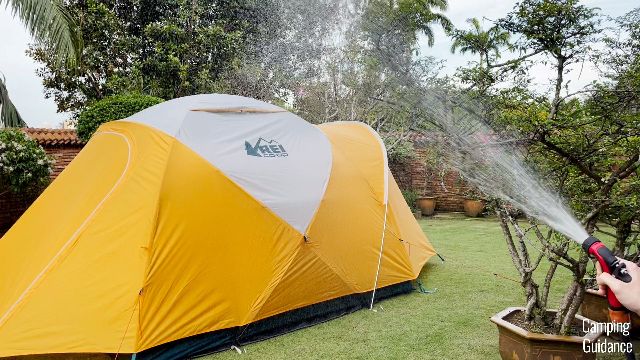
Second, the Base Camp also has the most user-friendly vents of all the tents on this list. These were the only vents that I could open and shut from the inside of the tent. As for the rest of the tents, I had to go outside to open or close their vents.
Definitely a useful feature to have when you want a little more ventilation in the tent.

Third, the Base Camp has a lot less mesh on the inner tent itself, which again, keeps it from feeling drafty in the cold. Check out how the Base Camp looks like without the rainfly; notice how there’s a lot more fabric than mesh?
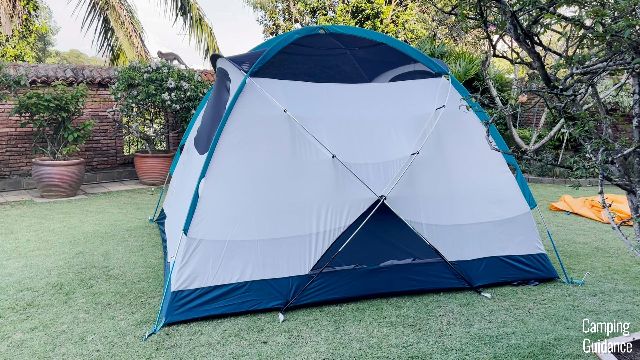
In comparison, the Wawona’s entire front wall is made almost entirely of mesh. This can be extremely cold and drafty in the shoulder season. It’s definitely not made for that.

On top of just being perfect for the shoulder season, the REI Base Camp 6 has plenty of other pros. For example, it has 2 huge vestibules; I used the smaller one for storage gear, and the bigger one for lounging around.

Also, for a 6-person tent, this Base Camp has a whopping 14 pockets and 20 loops. Easily the most storage options of all the other tents here.
The biggest con of this Base Camp has got to be the carry bag though. It’s a side-loading carry bag, and it’s not even appropriately big enough, so sometimes it can be a struggle to get everything back in. I’d recommend changing this out to a more user-friendly stuff sack or duffel bag.

More info on the REI Base Camp 6:
3. REI Co-op Wonderland 6 (Best Cabin Tent)
Key Info
- Peak height: 81 inches
- Length: 10 feet
- Width: 8 feet 3 inches
- Tent base area: 82.5 square feet
- Vestibule area: None
- Materials: 150D polyester (flooring), 75D polyester (tent body), aluminum (poles), YKK (door zippers only)
- Packed size: 30 x 15 x 10 inches
- Weight: 23.6lbs.
- Storage: 8 pockets, 2 loops
- Other features: 2 awnings, 1 room divider, mud room can be purchased separately
- Ventilation: 2 vents, 2 doors, 4 windows, lots of ceiling mesh
- Set Up Timing (1P): 19.5 minutes
- Take Down Timing (1P): 16.5 minutes
Pros and Cons
Summary
Moving onto my choice for the best cabin tent, I’ve got to pick the REI Wonderland 6.
There are 3 different cabin tents in this video, and the Wonderland scored the highest of them all.
- REI Wonderland 6: 7.5/10
- Eureka LX 6: 7.0/10
- Caddis Rapid 6: 7.0/10
Why?
Well, first, it has the most vertical walls I’ve ever seen in a cabin tent (those on the right and left width of the tent). In fact, I can press my body against the side wall, and stand completely upright against the wall, which basically shows you how vertical it is.

On the other hand, for most regular cabin tents, the side walls are a little less vertical. The blue line shows the slight slope of the walls of the Eureka Copper Canyon LX 6. The red line is a vertical line straight up. Compare the 2 in this picture below:

Second, there’s a ton of livable space inside the Wonderland, because you get the peak height throughout the entire length of the tent. Just look at how roomy the Wonderland looks inside:

Third, the Wonderland has the best quality doors that I’ve seen in a family camping tent, not just the tents on this list. The zippers are YKK, unzipping/zipping takes just 3 seconds, I could do so completely one-handed, the doors are huge, and I never had to duck when getting in and out of the tent through the doors.

Fourth, it has more hot day ventilation than any of the other tents on this list. For regular summer cabin tents (like the Eureka and Caddis Rapid), only the roof has ceiling mesh, plus a few large or maybe even not so large windows.
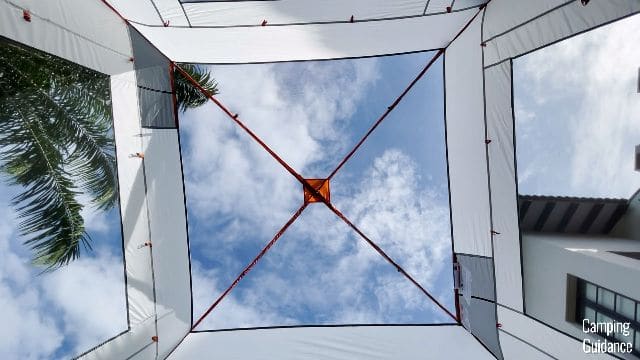
In comparison, for the Wonderland, the mesh doesn’t just cover only the roof, it extends down the sides of the tent as well, and I think easily more than half the tent is covered in mesh.
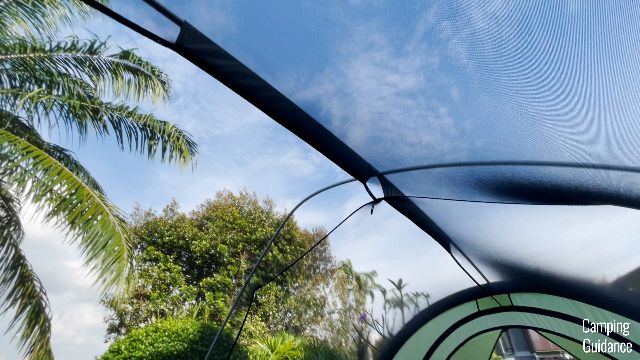
And that’s why the REI Wonderland 6 easily beats the other cabin tents in this list.
However, like all cabin tents, rain and wind protection won’t be quite as good. That’s because the rainfly is usually much shorter and thus offers less rain protection.
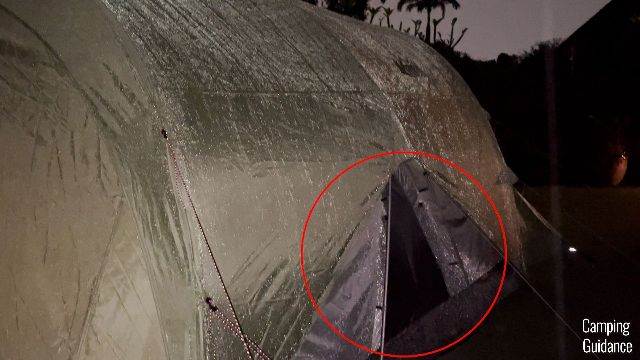
Also, the vertical side walls do not shed wind as easily, as compared to the Wawona or the Base Camp (both of which are dome-shaped and shed wind much better).
So, I’d recommend the REI Wonderland 6 only if you’re not expecting torrential rain or wind, and you’re more of a fair weather camper than anything else.
More info on the REI Wonderland 6:
4. Caddis Rapid 6 (Fastest Set Up)
Key Info
- Peak height: 77 inches
- Length: 9 feet 9 inches
- Width: 9 feet 9 inches
- Tent base area: 95.1 square feet
- Vestibule area: None
- Materials: 210D polyester (flooring), 190D polyester (tent body), steel (pre-attached poles), fiberglass (rainfly pole)
- Packed size: 50 x 15 x 9.5 inches
- Weight: 25.0lbs.
- Storage: 6 pockets, 1 loop, 1 gear loft
- Other features: 1 power port
- Ventilation: 1 window, 1 door, 3 vents (these become 3 windows without the rainfly)
- Set Up Timing (1P): 9.5 minutes
- Take Down Timing (1P): 7.5 minutes
Pros and Cons
Summary
If you’re looking for a 6-person tent that’s super easy to set up, the best pick for you has got to be the Caddis Rapid 6. It’s the only instant tent in this list, and the only tent that sets up in less than 10 minutes.
On the other hand, the other 2 cabin tents in this list take anywhere between 50-100% longer to set up (not an exaggeration!):
- Eureka LX 6 set up: 14 minutes (50% longer)
- Wonderland 6 set up: 19.5 minutes (100% longer)
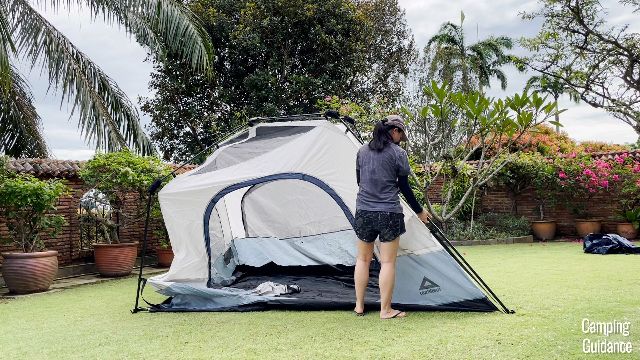
Packing it away is even faster, and it took me just 7.5 minutes.
This is because of the instant mechanism of the Caddis Rapid 6, which I found to be very high quality. The instant center hub is very thoughtfully designed and user-friendly (better than most instant tents I’ve tested), and the inside of the tent underneath the hub and joints are reinforced with extra fabric for added durability.
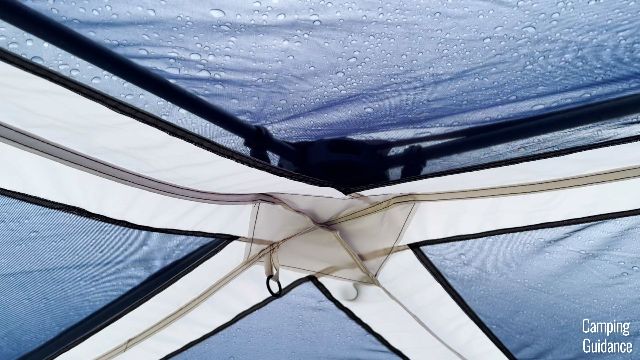
And we’re not even done with the pros. I also found ventilation to be really good, with pretty big windows on every wall of the tent (3 of which become huge vents with the rainfly in place).
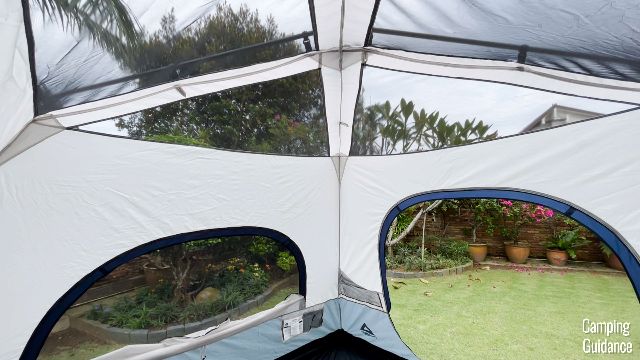

On top of that, the materials used to construct this tent are also super high quality, ranging from 190D polyester for the rainfly and tent body, to 210D polyester for the flooring. This is much thicker than all the other tents on this list, which come in at only 75D-150D polyester.
But of course, instant tents tend to be much longer, and this Caddis Rapid 6 is no exception. It’s at least one and a half to two times longer than the other tents on this list.
Just check out what it looks like beside a Coleman Sundome 6, a Coleman Sundome 2, and a 32-ounce Nalgene bottle.
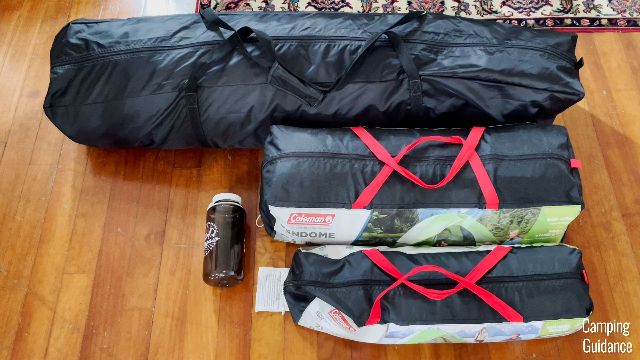
The Caddis Rapid 6 also has this exposed mesh at the front of the tent, which is, unfortunately, not great for strong winds and rain, because the wind will blow the rain right into this tent.

More info on the Caddis Rapid 6:
5. Eureka Copper Canyon LX 6 (Highest Peak Height)
Key Info
- Peak height: 84 inches
- Length: 9 feet 8 inches
- Width: 9 feet 8 inches
- Tent base area: 93.4 square feet
- Vestibule area: None
- Materials: 75D polyester (flooring & tent body), steel (wall poles), fiberglass (roof and rainfly poles), SBS (zippers)
- Packed size: 29 x 13 x 9 inches
- Weight: 22.4lbs.
- Storage: 4 pockets, 5 loops, 2 gear lofts
- Other features: 1 power port, 4 liner loops
- Ventilation: 4 windows, 1 door
- Set Up Timing (1P): 14 minutes
- Take Down Timing (1P): 12 minutes
Pros and Cons
Summary
I found the Eureka Copper Canyon LX 6 to be an incredibly spacious tent, and it’s the only tent on this list to have a peak height of a full 7 feet. Even when I stretched my arm upwards as much as I could, and I stood on tiptoes at the same time, I couldn’t even reach the top of the tent.
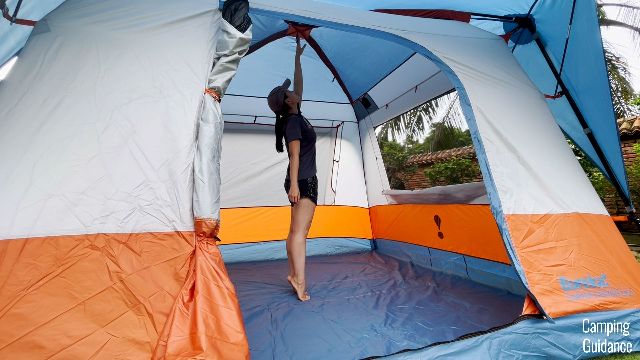
The lowest height in this tent, which is at the four corners, is about 5.5 feet, which is still taller than my height (5’3), so I could literally stand up everywhere inside this tent.
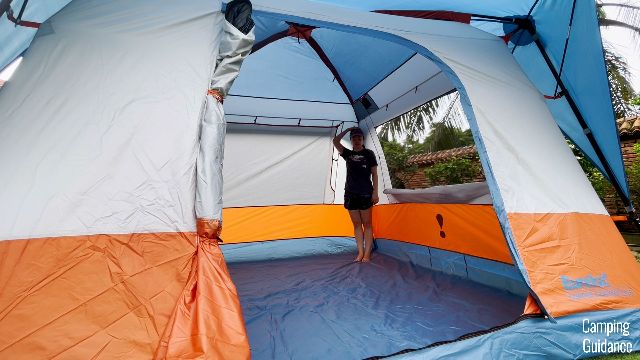
Also, I found it pretty straightforward and simple to set up this Eureka LX 6.
Packing it away was very quick as well, thanks to the incredibly user-friendly carry bag. It’s so awesome that I could zip it up one-handed, and it’s easily the best carry bag of all the other tents here.

This tent is also one of the less expensive tents on this list. To be more specific, it’s mid-way between a budget tent like Coleman, and more expensive higher-end tents like The North Face and REI.
So, this Eureka LX 6 is perfect for folks who want more than a budget tent, but don’t want to fork over double the price for a much higher-end tent. It’s also perfect for folks who love cabin tents and the livability inside their tents.
However, the 2 biggest cons of this tent has got to be the lack of wind and rain protection. Because the profile of this tent is so huge, it blows away super easily.
All I had to do was to remove the guylines, as well as the 2 tent stakes at the bottom front of the tent, and the entire tent just blew over in a light breeze of no more than 5 to 10 miles per hour.
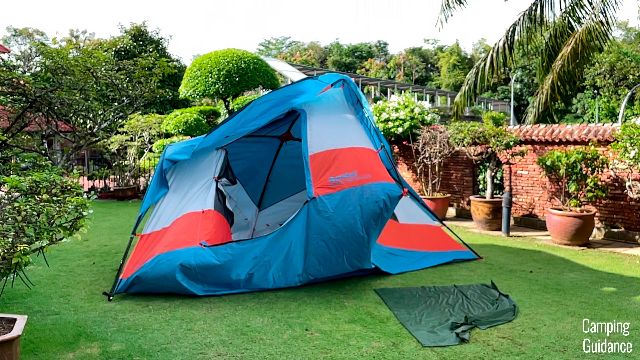
Luckily, I didn’t get to remove the back 2 tent stakes; otherwise, the tent would have completely blown away!
Also, the rainfly is very small (typical of most cabin tents), so rain protection won’t be as good as the Wawona or the Base Camp 6. It’s perfectly functional in light to moderate rain though, but it won’t be able to last more than a few hours in heavy rain.
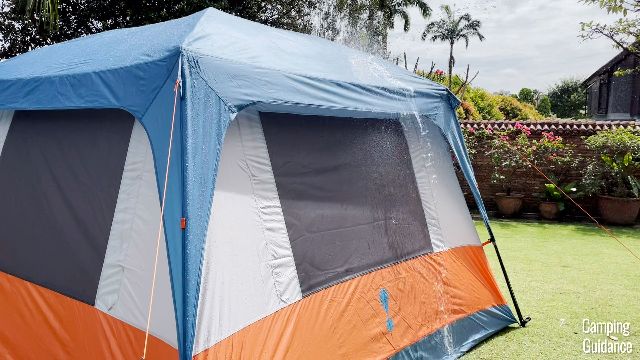
More info on the Eureka LX 6:
6. Coleman Sundome 6 (Best Budget Pick)
Key Info
- Peak height: 74.5 inches
- Length: 9 feet 8 inches
- Width: 9 feet 7 inches
- Tent base area: 92.6 square feet
- Vestibule area: None
- Materials: Polyethylene (flooring), 68D polyester (tent body), fiberglass (poles)
- Packed size: 27 by 12 by 9.5 inches
- Weight: 16.0lbs.
- Storage: 2 pockets, 1 loop
- Other features: 1 e-port
- Ventilation: 1 door, 2 windows, 2 mesh wall vents, 1 ground vent
- Set Up Timing (1P): 11.5 minutes
- Take Down Timing (1P): 10 minutes
Pros and Cons
Summary
The biggest pro of the Coleman Sundome 6 is easily its highly inexpensive price-tag. If you’re looking for a decent quality budget 6-person tent, I’ve tested and found the Coleman Sundome 6 to be one of the best.
The Sundome 6 has, surprisingly, a decent number of pros, on top of just its price-tag. For example, I found the set up and pack away to be very manageable as a single person. After the instant Caddis Rapid 6 (Recommendation #4), the Sundome 6 is actually the quickest.
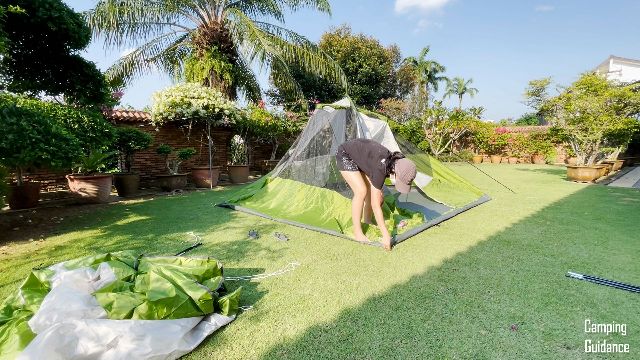
It also has tons of rainy day ventilation, complete with not just 2 mesh wall vents, which span the entire width of the tent, but also a small ground vent at the back, for a whopping 3 vents in total.
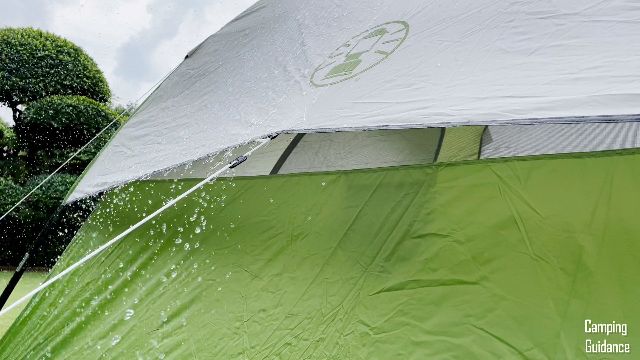
It’s also very lightweight, the second-lightest tent on this list, but then again, that’s because budget materials tend to be lighter than higher quality materials.
As for cons, I think the biggest one is prepping this tent for rainy days. I highly recommend sealing the bathtub flooring to tent body seam at the bottom of the tent, because that’s always the first place to leak in the heavy rain (after just ~30 minutes). This seam is in this picture here:
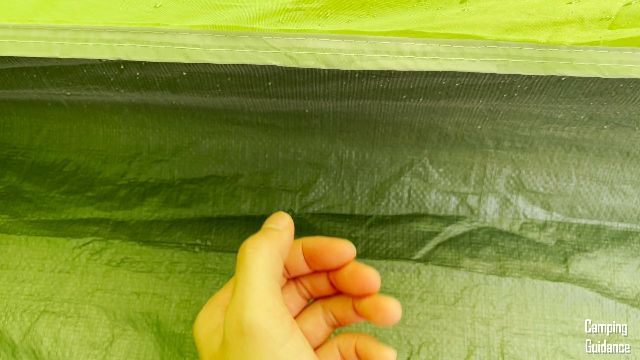
Higher quality tents will come with taped seams, but for budget tents like this Sundome 6, you’ve got to do it yourself. A waterproofing spray (to coat the tent fabric) will be useful as well.
And also, as is typical of most budget tents as well, there’s not a ton of storage, with just 2 pockets and 1 lantern loop. That’s way too little for a 6-person tent.
More info on the Coleman Sundome 6:
7. NTK Cherokee 6 (Alternative Budget Pick)
Key Info
- Peak height: 70 inches
- Length: 9 feet 7 inches
- Width: 9 feet 7 inches
- Tent base area: 91.8 square feet
- Vestibule area: None
- Materials: Polyethylene (flooring), 68D polyester (tent body), fiberglass (poles)
- Packed size: 26 x 12 x 8.5 inches
- Weight: 15.2lbs.
- Storage: 2 pockets (each split into 4 smaller pockets), 1 loop
- Other features: 1 e-port
- Ventilation: 1 door, 1 window, 2 vents
- Set Up Timing (1P): 13 minutes
- Take Down Timing (1P): 10 minutes
Pros and Cons
Summary
I bought the NTK Cherokee 6 to pit it against Coleman’s Sundome 6, and found that the Sundome was better in almost every way.
So, I would recommend the NTK Cherokee 6 only if the Sundome is out of stock. The Cherokee isn’t a bad budget tent; the Sundome is just better.
Here’s every way in which the Sundome beats the Cherokee:
| Test | Sundome 6 | Cherokee 6 |
|---|---|---|
| Set up timing | 11.5 minutes | 13 minutes |
| Peak height | 74.5 inches | 70 inches |
| Base area | 92.6 sq. ft. | 91.8 sq. ft. |
| No. of vents | 3 vents | 2 vents |
| No. of guylines | 6 guylines | 4 guylines |
On the other hand, how does the Cherokee beat the Sundome?
- Slightly bigger storage pockets
- A little more lightweight (0.8lbs. lighter)
- A little more compact (1 inch shorter in length and in height)
The pros of the Sundome clearly outweigh the pros of the Cherokee (at least for me), so that’s why the Sundome is my go-to budget camping tent.
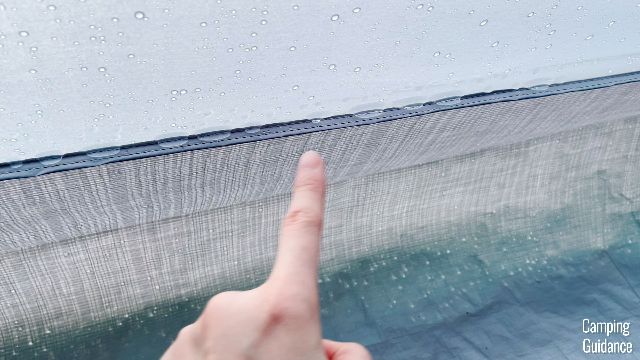
If you want to get the Cherokee though, remember to do the usual waterproofing prep work of seam sealing and using waterproofing spray, if you’re expecting heavy rains.
More info on the NTK Cherokee 6:
Recommendation Summary
Here’s a quick summary of all the 6-person tents that I bought and tested for this review:
- Best Overall: The North Face Wawona 6
- Best for Rain: The North Face Wawona 6
- Best for Summer: The North Face Wawona 6
- Best Value for Money: The North Face Wawona 6
- Runner-Up Pick: REI Base Camp 6
- Best for Colder Weather: REI Base Camp 6
- Best Cabin Tent: REI Wonderland 6
- Best for Hot Weather: REI Wonderland 6
- Runner-Up Cabin Tent: Caddis Rapid 6 or Eureka Copper Canyon LX 6
- Easiest to Set Up: Caddis Rapid 6
- Highest Peak Height: Eureka Copper Canyon LX 6
- Best Budget Pick: Coleman Sundome 6
How I Tested My 6-Person Tents
I put each 6-person tent through 7 different tests:
- Ease of use (set up and pack away)
- Spaciousness (peak height, livability, base area, mattress sizing, vestibule area, total area)
- Comfort and features (doors, storage, room dividers, power ports)
- Ventilation (hot day, rainy day)
- Weather protection (heavy rain test and wind test)
- Quality (materials used, mesh & seam quality, seam taping)
- Portability (weight, packed size)
Overall Ratings
Here’s a cool graphic you can use to compare each of the seven 6-person tents that I bought and tested for this review:

Now, let’s get into a more detailed explanation of how I came to these ratings.
1. Ease of Use
I split this test into 2 different parts, which is the ease of:
- Set up; and
- Take down and pack away.
Set Up Timing
Here’s how long each 6-person tent took me to set up, including staking and guying out the tents:
| 6-Person Tent | Set Up Timing (1P) |
|---|---|
| Caddis Rapid 6 | 9.5 minutes |
| Coleman Sundome 6 | 11.5 minutes |
| NTK Cherokee 6 | 13 minutes |
| Eureka Copper Canyon LX 6 | 14 minutes |
| REI Base Camp 6 | 17.5 minutes |
| REI Wonderland 6 | 19.5 minutes |
| The North Face Wawona 6 | 20 minutes |
I was able to set up every one of these tents on my own, so these timings are all 1-person timings.
How to Set Up Each Tent
The quickest tent to set up is the instant Caddis Rapid 6. And that’s because all the poles are pre-attached; all I had to do was to unfold them, pick them up, and extend each pole upwards, then set up the rainfly. It’s as simple as that.
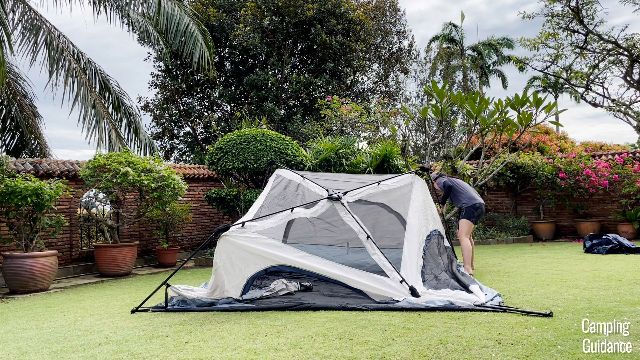
Next up, we have the Coleman Sundome 6, which has a very simple 3-pole set up. The 2 main poles are to be crisscrossed over each other for the tent body, and the last pole is for the rainfly. Overall, a very simple dome tent setup, which is why it didn’t take very long.

The NTK Cherokee 6 has the exact same 3-pole set up as the Sundome 6, 2 for the tent body, and 1 for the rainfly.

However, while the Sundome comes with user-friendly Velcro attachments to secure the rainfly, the Cherokee comes with these less user-friendly straps instead, which I had to tie up, and it took so much longer (1.5 minutes longer, to be more specific).
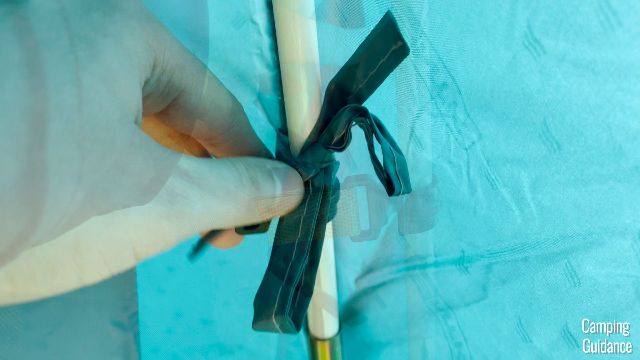
The next tent is the Eureka Copper Canyon LX 6, which has a standard 6-pole cabin tent set up.
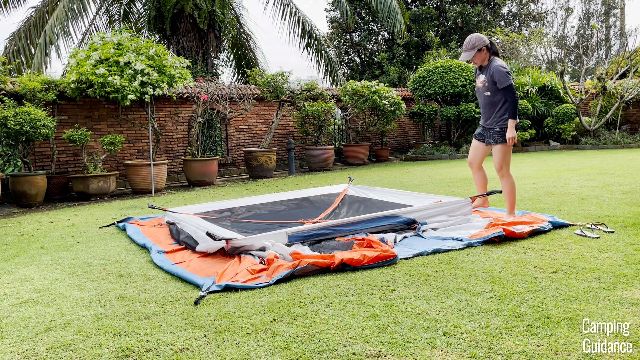
The 2 fiberglass poles are for the roof of the tent (above), and the 4 steel leg poles are for the walls of the tent (below). After that, just secure the rainfly in place.
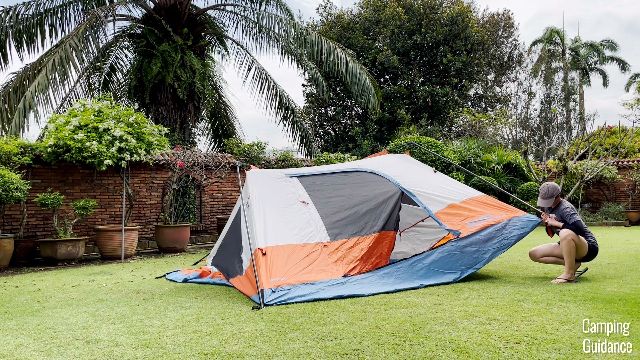
Pro Tip #1: Take note here that simple cabin tents usually take a little longer to set up than simple dome tents, mainly because you have more poles to deal with.
The REI Base Camp 6 has a slightly more complex dome set up, with 5 poles instead. The first 2 poles, which are the blue-colored poles, are to criss-cross over each other, so, the same as the Sundome and Cherokee.
However, there’s still another 2 of these black poles to set up, and these are to intersect the 2 blue poles, and this reinforces the main tent body. So, 4 poles (instead of 2) for the main tent body.

On top of that, the Base Camp also has 2 vestibules to be set up, 1 at the front (with the last pole – the vestibule pole) and another at the back, so it takes a little longer than your simple dome tent that doesn’t have any vestibule.

Pro Tip #2: Basically, the more features a tent has, the longer the set up will take you.
Next up, we have the REI Wonderland 6, which also comes with 5 poles. The first pole runs the entire length of the Wonderland, at the top, and the other 4 poles are for the walls of the tent.

I think the Wonderland has a very unique cabin tent shape, so the setup was a little bit more complex than your standard cabin tent (like the Eureka).
And The North Face Wawona has a 4-pole setup, which is, like the Base Camp, a slightly more complex dome tent setup. The first 2 poles (orange) crisscross over each other to give you the main tent body, and there’s a third pole (black) for the front of the tent.

The main reason this Wawona took me the longest is because the rainfly has a lot of fabric and pole clips, which always catch either on the tent fabric or the poles. So, it takes me 2-3 tries to get it up, compared to 1 try for the rest of the tents.
The last pole helps to shape the vestibule at the front, and that’s the gist of the setup. Overall, still manageable.
Pack Away Timing
Now, for the ease of pack away, here’s how long each 6-person tent took me to pack away, back into the carry bag, starting from the easiest:
| 6-Person Tent | Pack Away Timing (1P) |
|---|---|
| Caddis Rapid 6 | 7.5 minutes |
| Coleman Sundome 6 | 10 minutes |
| NTK Cherokee 6 | 10 minutes |
| Eureka Copper Canyon LX 6 | 12 minutes |
| The North Face Wawona 6 | 14 minutes |
| REI Base Camp 6 | 15 minutes |
| REI Wonderland 6 | 16.5 minutes |
The Caddis Rapid 6 was again the easiest, and it’s because the poles are pre-attached. I didn’t have to un-sleeve then pack away the poles, I just needed to fold the poles and the tent body up together. The carry bag was also nice and big, and I had no issues at all fitting everything back in.
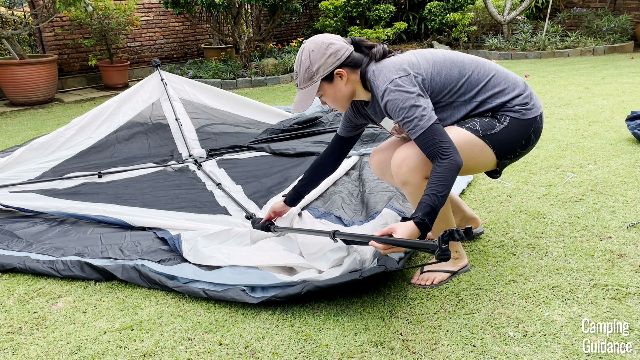
As for the remaining 6 non-instant tents, I think the 2 biggest things that affect how easily each tent packs away, is the:
- Carry bag; and
- Amount of material you have to pack away.
Carry Bag Design
The Sundome and Cherokee both have less features and less material to pack up, plus the carry bag is top-loading and the opening is decently big, so these were the easiest after the Caddis Rapid.

The Eureka actually has a very nice top-loading carry bag, with both Velcro and zips, the opening is also decently big, but it took slightly longer because cabin tents have more poles to pack away than simple dome tents.
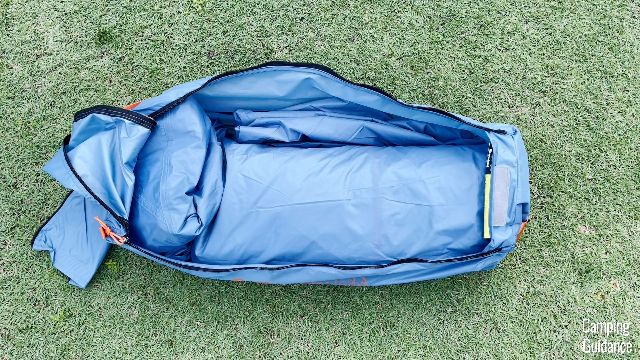
The Wawona’s top-loading carry bag has a super huge opening. So, even though there’s quite a lot of material to pack away, more than your simple dome tent, I found it incredibly easy to get everything back in because of this super huge opening.
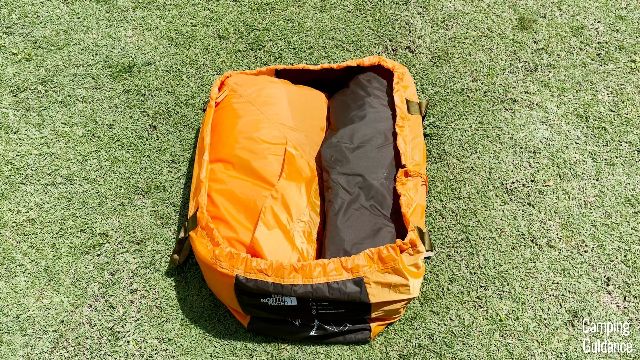
On the other hand, both my REI tents were a little bit more of a struggle, because both the carry bags are side-loading. The opening is at the side, so it’s a lot smaller, I don’t really like this, and it can sometimes be more of a struggle to get everything packed up.

Ease of Use Ratings
And with that, for the ease of use, here’s how I rated each of my 6-person tents:
| 6-Person Tent | Ease of Use Ratings |
|---|---|
| Caddis Rapid 6 | 10.0 |
| Coleman Sundome 6 | 9.0 |
| NTK Cherokee 6 | 8.5 |
| Eureka Copper Canyon LX 6 | 8.0 |
| REI Base Camp 6 | 6.5 |
| The North Face Wawona 6 | 6.5 |
| REI Wonderland 6 | 5.5 |
2. Spaciousness
For spaciousness, I looked at the peak height, livability, and the base area of each tent.
Peak Height
Here’s the peak height of each 6-person tent from the lowest to the highest:
| 6-Person Tent | Peak Height |
|---|---|
| NTK Cherokee 6 | 70 inches |
| REI Base Camp 6 | 73 inches |
| Coleman Sundome 6 | 74.5 inches |
| The North Face Wawona 6 | 77 inches |
| Caddis Rapid 6 | 77 inches |
| REI Wonderland 6 | 81 inches |
| Eureka Copper Canyon LX 6 | 84 inches |
The first four are dome tents, while the next three are more cabin-shaped, which tend to have higher peak heights.
Livability
For the livability inside the tent, I like to look at the slope of the walls.
Basic dome tents, which have only 2 poles criss-crossing each other, have the least livable space, because the walls slope inwards the most.

On the other hand, the Base Camp is a more complex dome tent, with 4 intersecting poles, and the tent body even has these pole clips and buckles to be attached to the poles. This pulls the tent fabric outwards, giving you much more livable space than basic dome tents.
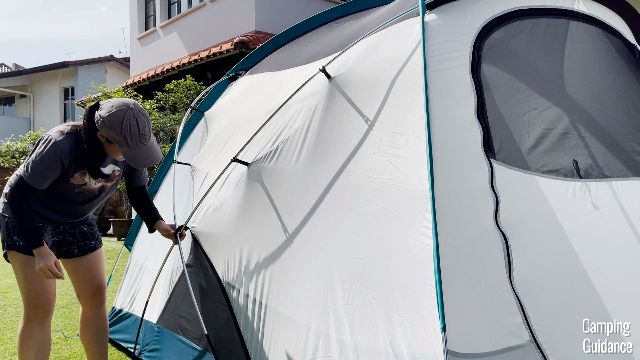
So, in my Base Camp, my head doesn’t even touch the wall when I sit up at the sides of the tent, while in my basic Sundome, my head grazes the wall, and definitely feels tighter.

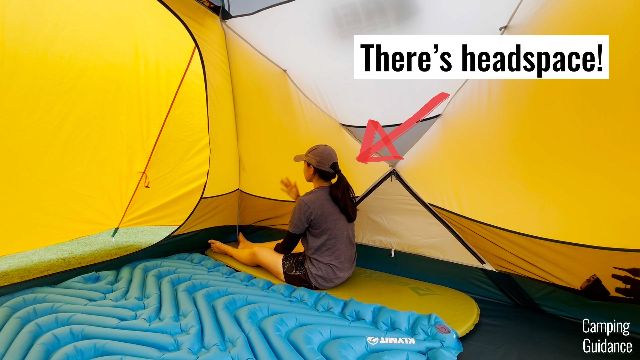
On par with the Base Camp, we’ve also got the Wawona, which has a completely vertical front wall, because of the front extra pole. Here’s a side view of the Wawona, and there’s extra livable space that you won’t get in a basic dome:
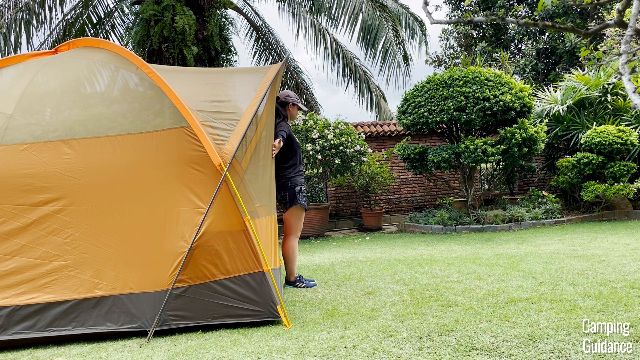
Regular cabin tents, like the Caddis and Eureka, have side walls that are almost vertical, which gives you a lot more livable space than any dome tent.
In fact, for both the Eureka and the Caddis, the lowest height in the tent is about 66 inches and 68 inches respectively. So, I could stand up everywhere inside these 2 cabin tents. (I’m 5’3.)

And the most spacious is easily the Wonderland 6. 2 reasons why.
First, for most cabin tents, the leg poles are actually set up a little bit angled, so your side walls are not completely vertical (but still much better than dome tents!). Check out the slant of the Eureka LX 6 compared to a completely vertical red line upwards:

On the other hand, the Wonderland has completely vertical left and right side walls.

And second, the peak height of the Wonderland runs the entire length of the tent, give or take a few inches.

Base Area
For the base area, I looked at not just the inner tent, but also, any vestibules that the tent has.
For the inner tent, here’s my personal calculations of the length, width, and the base area of each of these tents, excluding any vestibules for now:
| 6-Person Tent | Length | Width | Area |
|---|---|---|---|
| The North Face Wawona 6 | 9.67 ft | 7.83 ft | 75.7 sq. ft. |
| REI Base Camp 6 | 9.08 ft | 9.08 ft | 82.5 sq. ft. |
| REI Wonderland 6 | 10.0 ft | 8.25 ft | 82.5 sq. ft. |
| NTK Cherokee 6 | 9.58 ft | 9.58 ft | 91.8 sq. ft. |
| Coleman Sundome 6 | 9.67 ft | 9.58 ft | 92.6 sq. ft. |
| Eureka Copper Canyon LX 6 | 9.67 ft | 9.67 ft | 93.4 sq. ft. |
| Caddis Rapid 6 | 9.75 ft | 9.75 ft | 95.1 sq. ft. |
You might notice that there’s quite a humongous 20 square feet difference between the smallest Wawona and the biggest Caddis Rapid.
Mattress Sizing
But surprisingly, every single one of these 6-person tents can fit 6 single sleeping pads, even the smallest Wawona 6.
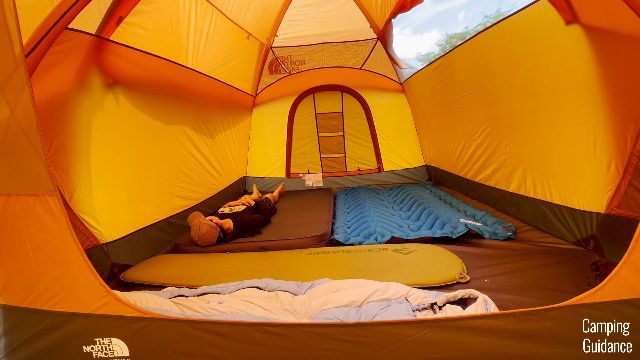
But after the 6 pads go in, there’s hardly any space leftover for anything else.
As for queen bed sizing though, only my Wonderland was able to fit 2 queen beds, and that’s because the base area is a rectangle.
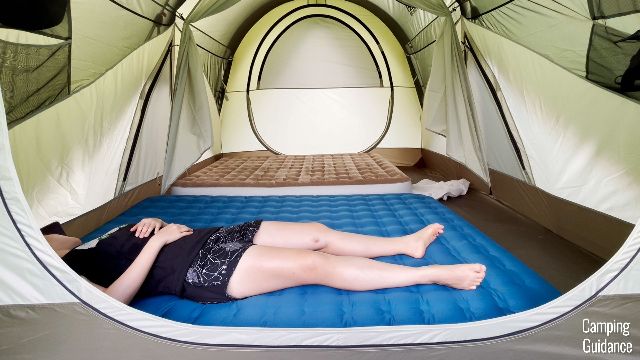
The rest have base areas that are square in shape, and while most of them could fit 2 of my almost Queen beds, 2 actual queen beds of 80 by 60 inches would not be able to fit.
- Alps Mountaineering Vertex Airbed (blue): 80 by 56 inches
- Etekcity Upgraded Camping Mattress (brown): 80 by 59 inches
| 6-Person Tent | Single Pads | Queen Beds | Base Shape |
|---|---|---|---|
| REI Base Camp 6 | 6 | 1 | Square |
| NTK Cherokee 6 | 6 | <2 | Square |
| Coleman Sundome 6 | 6 | <2 | Square |
| The North Face Wawona 6 | 6 | <2 | Rectangle |
| Caddis Rapid 6 | 6 | <2 | Square |
| Eureka Copper Canyon LX 6 | 6 | <2 | Square |
| REI Wonderland 6 | 6 | 2 | Rectangle |

Vestibule Area
Moving onto the vestibule area, only 2 of my tents have vestibules, and here are the details:
| 6-Person Tent | Vestibule Area |
|---|---|
| NTK Cherokee 6 | 0 |
| Coleman Sundome 6 | 0 |
| Caddis Rapid 6 | 0 |
| REI Wonderland 6 | 0 |
| Eureka Copper Canyon LX 6 | 0 |
| The North Face Wawona 6 | 51.0 sq. ft. |
| REI Base Camp 6 | 52.4 sq. ft. |

Total Area
For the total area, I just combined the inner tent base areas and the vestibule areas, and here’s the final tally, from the biggest to the smallest:
| 6-Person Tent | Tent | Vestibule | Total Area |
|---|---|---|---|
| Base Camp 6 | 82.5 sq. ft. | 52.4 sq. ft. | 134.9 sq. ft. |
| Wawona 6 | 75.7 sq. ft. | 51.0 sq. ft. | 126.7 sq. ft. |
| Caddis 6 | 95.1 sq. ft. | 0 | 95.1 sq. ft. |
| Eureka LX 6 | 93.4 sq. ft. | 0 | 93.4 sq. ft. |
| Sundome 6 | 92.6 sq. ft. | 0 | 92.6 sq. ft. |
| Cherokee 6 | 91.8 sq. ft. | 0 | 91.8 sq. ft. |
| Wonderland 6 | 82.5 sq. ft. | 0 | 82.5 sq. ft. |
Spaciousness Ratings
And with that, here’s how I decided to rate all my 6-person tents for spaciousness:
| 6-Person Tent | Spaciousness Ratings |
|---|---|
| Eureka Copper Canyon LX 6 | 8.3 |
| REI Wonderland 6 | 8.0 |
| REI Base Camp 6 | 7.8 |
| The North Face Wawona 6 | 7.8 |
| Caddis Rapid 6 | 7.3 |
| Coleman Sundome 6 | 5.8 |
| NTK Cherokee 6 | 5.5 |
3. Comfort and Features
For comfort and features, I’m going to focus on the door quality, storage options, plus any other features.
Doors
I think having good quality doors is very important, and here are some things I look at:
- How many doors are there?
- How big are the doors?
- Can I get in without ducking?
- Can I unzip or zip the door up one-handed?
- How long does zipping/unzipping take?
- Do the zippers snag?
Now, let’s start the analysis.
Here’s the number of doors that each 6-person tent has, from the most to the least. I’ve also arranged all these tents according to their door quality, from the best to the worst:
| 6-Person Tent | Number of Doors |
|---|---|
| REI Wonderland 6 | 2 |
| The North Face Wawona 6 | 2 |
| REI Base Camp 6 | 2 |
| Coleman Sundome 6 | 1 |
| NTK Cherokee 6 | 1 |
| Eureka Copper Canyon LX 6 | 1 |
| Caddis Rapid 6 | 1 |
Let’s start with the best – the Wonderland 6.
There are 2 doors, both these doors are huge (dimensions are 66 x 64 inches for each door), and each door takes up almost the entire wall of the tent. Also, the doors are super tall (72.5 inches from the ground to the top of the door), so I didn’t even have to duck when getting in and out of the tent.

Both doors are completely snag free, I could unzip and zip each door completely one-handed, with no fumbling at all, and it takes just 3 seconds. After that, I just tuck the door fabric into one of the pockets next to the door, taking another 4 seconds. One of the best doors I’ve seen so far.
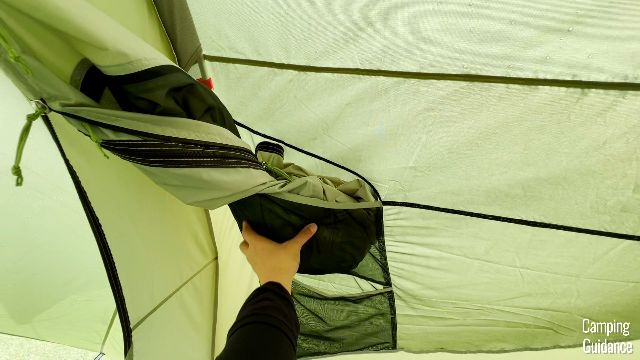
The second best door that I found is the front door of the Wawona 6. It’s also super huge (dimensions are 60 x 58 inches for each door), and I didn’t have to duck when getting in and out of the tent (70 inches from the ground to the top of the door).

It’s also completely snag-free, I needed to use only 1 hand to unzip the entire door, and it takes just 3 seconds.
After that, to keep the door open, I had to roll the fabric up neatly, and tie it to the top with these 2 toggles, so not quite as user-friendly as the Wonderland’s door pockets, because it takes about 15 seconds to do so.
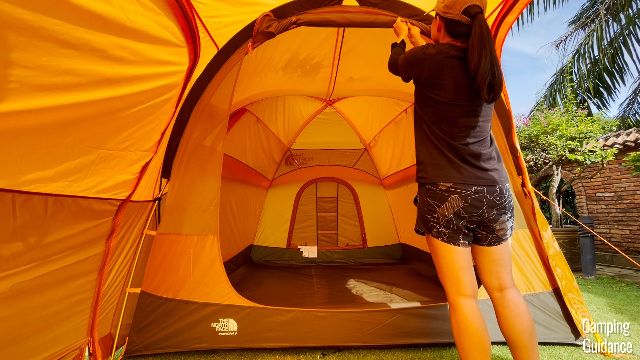

Another reason why the Wonderland is still better is because the back door of the Wawona is super small, and not as user-friendly.
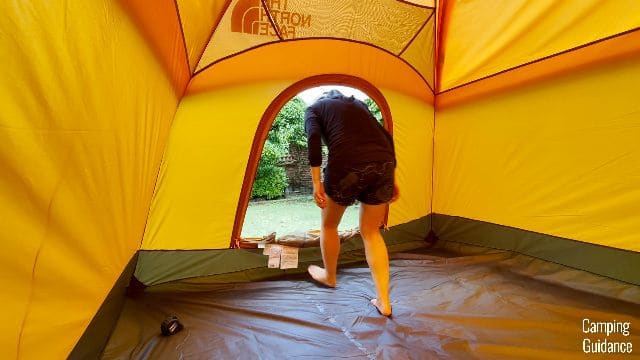
Next up, we have the Base Camp 6. While the 2 doors are pretty huge (dimensions are 74 x 59 inches each), they’re not quite as tall (62.5 inches from the ground to the top of the door), so I had to tilt my head a little bit to get in and out of the tent.

And while the unzipping is completely snag-free and one-handed, for the zipping up, I sometimes had to use 2 hands to pull the zipper past this bend here, so not 100% one-handed. And that’s because there aren’t any extra stake loops beneath the door, which the Wonderland and the Wawona have.
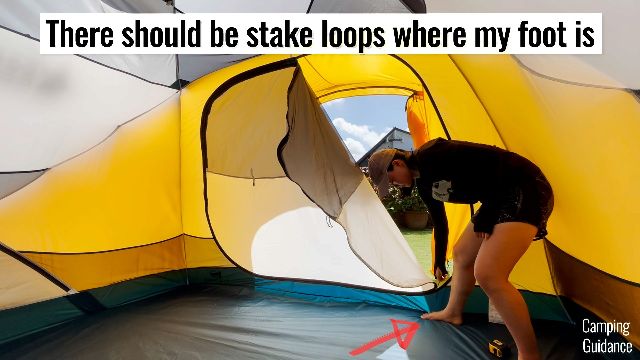
The rest of the tents have only 1 door each, so that in itself is already a big downgrade. On top of that, the doors on these tents are quite a bit smaller in size, they’re not as tall so I had to duck when going through all of them. Here are their dimensions:
- Coleman Sundome 6: 54 x 42 inches in size, 56 inches from the ground to the top of the door
- NTK Cherokee 6: 51 x 43 inches in size, 55 inches from the ground to the top of the door
- Eureka Copper Canyon LX 6: 58 x 50 inches in size, 63 inches from from the ground to the top of the door
- Caddis Rapid 6: 58 x 55.5 inches in size, 58 inches from the ground to the top of the door
Also, each of them had this rain flap that will sometimes get in the way of the zippers. This was a bit annoying at times, and it definitely slows down the zipping process.

Surprisingly, the doors on the Eureka and Caddis were not that great.
I found the door on the Eureka to be super tight the first time I set this tent up, although it did break in after a few days, and I found the door on the Caddis to be quite snaggy, the snaggiest of all the tents in this article.
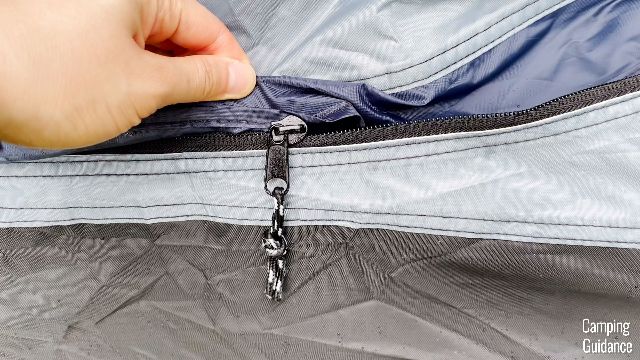
Storage
As for storage options, here’s a quick summary for each 6-person tent, from the most to least:
| 6P Tent | Pockets | Lofts | Loops | Total |
|---|---|---|---|---|
| Base Camp 6 | 14 | 0 | 20 | 34 |
| Wawona 6 | 9 | 0 | 8 | 17 |
| Wonderland 6 | 8 | 0 | 7 | 15 |
| Eureka LX 6 | 4 | 2 | 5 | 11 |
| Caddis 6 | 6 | 1 | 1 | 8 |
| Cherokee 6 | 2 | 0 | 1 | 3 |
| Sundome 6 | 2 | 0 | 1 | 3 |
As you can see, there’s a huge difference between the tent with the most storage options, and the tent with the least.
I found that the more premium tents have way more storage options. For example, the REI Base Camp 6 has huge pockets running all around the tent. It also has loops everywhere around the tent, on every single wall.

Budget tents, on the other hand, have much fewer storage options. I mean, my Sundome 6 has only 2 pockets and 1 loop at the top. That’s it.
Other Features
I also decided to take a very quick look at any other features that these tents have, and here’s a quick run-down.
| 6-Person Tent | Power Ports | Room Dividers |
|---|---|---|
| Base Camp 6 | 0 | 0 |
| Wawona 6 | 0 | 0 |
| Wonderland 6 | 0 | 1 |
| Eureka LX 6 | 1 (Zippered) | 0 |
| Caddis 6 | 1 (Velcro) | 0 |
| Cherokee 6 | 1 (Zippered) | 0 |
| Sundome 6 | 1 (Zippered) | 0 |
Weirdly enough, somehow all my higher-end tents didn’t have power ports, while the less expensive tents had 1 power port each.
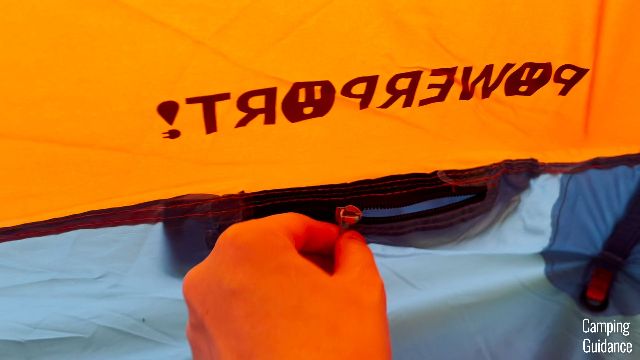
And also, only my Wonderland came with a room divider.
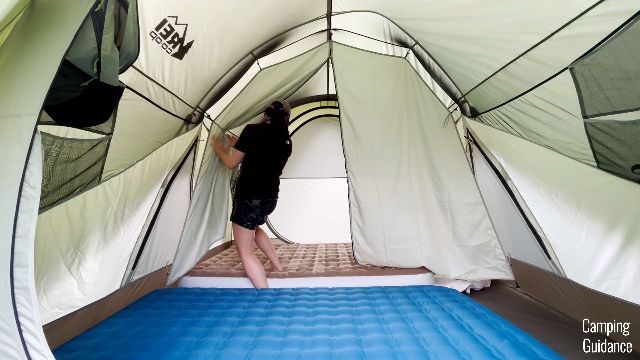
Features Ratings
And now, here’s how I rated each of my 6-person tents for comfort and features, with the emphasis being on the quality of the doors:
| 6-Person Tent | Features Ratings |
|---|---|
| REI Wonderland 6 | 9.8 |
| The North Face Wawona 6 | 8.6 |
| REI Base Camp 6 | 8.5 |
| Eureka Copper Canyon LX 6 | 5.8 |
| Coleman Sundome 6 | 5.8 |
| NTK Cherokee 6 | 5.8 |
| Caddis Rapid 6 | 4.8 |
4. Ventilation
For ventilation, I’m going to look at both hot day ventilation, as well as rainy day ventilation.
Hot Day Ventilation
For hot day ventilation, we’re going to take a look at these factors:
- The amount of ceiling mesh each tent has;
- The size of the windows that can be opened; as well as
- Any cross-ventilation there might be in the tent.
Easily the most ventilated tent is the Wonderland 6.
When I take the rainfly off, check out how much mesh there is on this tent. The mesh doesn’t just cover only the roof, it extends down the sides of the tent as well, and I think easily more than half the tent is covered in mesh.

I also got to enjoy 360 views, because of not just the 2 half-door windows (each with dimensions of 54 x 26 inches), but also the 2 bottom triangle windows (each with dimensions of 0.5 x 32 x 28 inches). You can see both of them in this picture below:
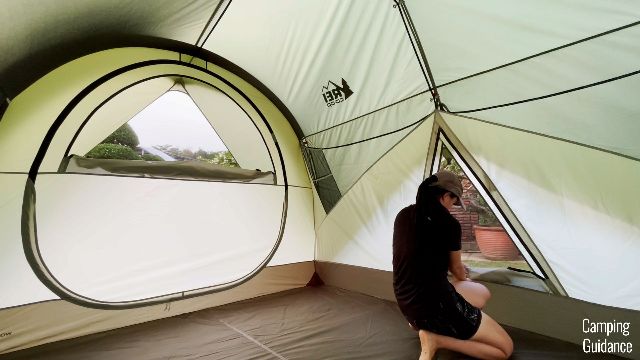
Adding in the cross-ventilation of the 2 doors, hot day ventilation in the summer is simply incredible.

Next up, we have the Caddis Rapid 6, with pretty big windows on every wall of the tent.
There are 4 windows in total. The front window measures 52 x 33.5 inches in dimensions, and each of the other 3 windows measure 63 x 22.5 inches. This gave me a total of 5,995 square inches of window ventilation.
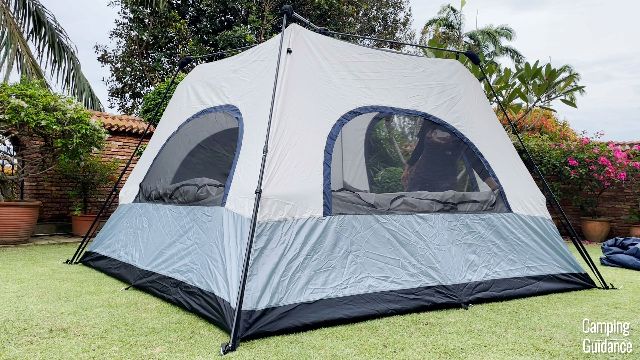
There’s also a good amount of ceiling mesh. But unlike the Wonderland, the ceiling mesh doesn’t extend down the sides of the tent. Plus, it only has 1 door, so there’s less cross-ventilation.

Following closely to the Caddis Rapid, we have our other cabin tent, the Eureka Copper Canyon LX 6. This tent also has the same ceiling mesh, only 1 door, plus pretty big windows on every wall of the tent.

But, I calculated the amount of window ventilation in the Eureka to be about 5% less than the Caddis Rapid.
The front window of the Eureka LX 6 measures 42 x 30 inches in dimensions, and the other 3 windows measure 51 x 29 inches in dimensions each. This gave me a total of 5,697 square inches of window ventilation (compared to the 5,995 sq. in. in the Caddis).

Pro Tip #3: Now that we’re done with our cabin tents, which tend to have a little more hot day ventilation, let’s move on to our 4 dome tents.
I think the best of the dome tents has got to be the Wawona 6. First, a good three-quarters of its front wall is made of mesh for tons of ventilation.
On top of that, the 4 walls of the tent all have mesh panels that join together at the top, and the extra front wall pole also extends the mesh outwards, giving you almost like the kind of ceiling mesh you get in cabin tents, which is really nice.
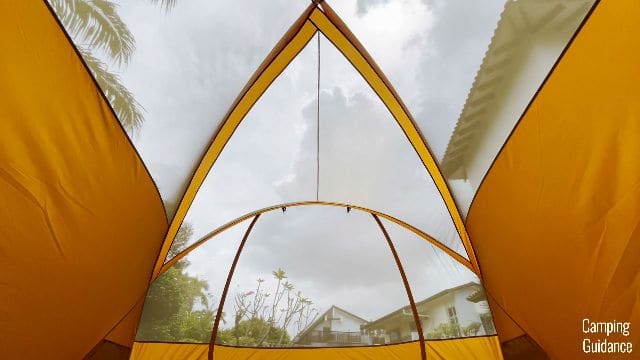
And you can also open the back window as well for more ventilation.
After the Wawona, I think the Sundome and Cherokee are about the same. The Sundome has 2 huge mesh walls (right & left wall), plus 2 windows (front & back wall), while the Cherokee has the same 2 mesh walls as the Sundome, but 1 window and 2 small mesh panels instead.
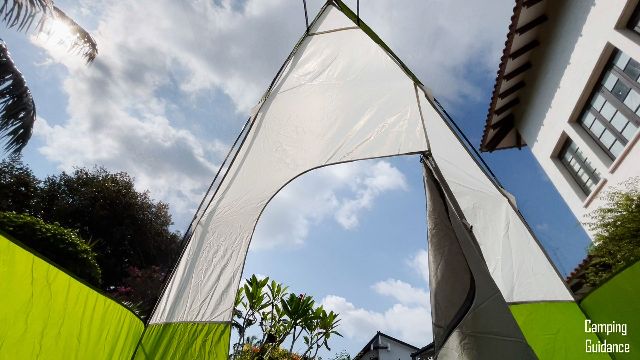
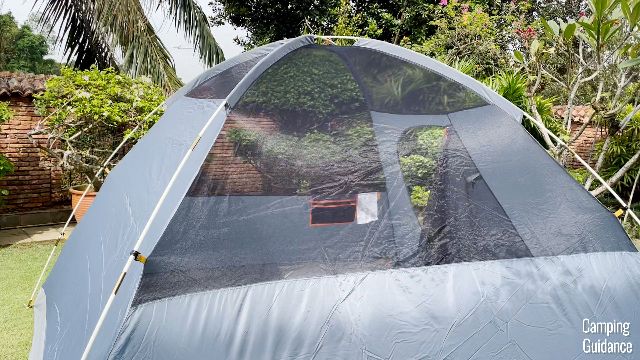
And finally, we have our Base Camp 6. There’s only a rather tiny skylight, 2 not even half-door windows, and 2 tiny mesh panels.
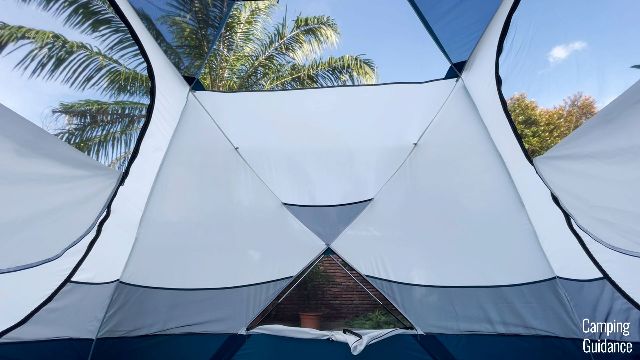
Rainy Day Ventilation
For rainy day ventilation, I looked for any vents or windows that could be kept open in the heavy rain, and I think the best tent has got to be, surprisingly, the Coleman Sundome 6.
| 6-Person Tent | Windows | Vents | Total |
|---|---|---|---|
| Coleman Sundome 6 | 2 | 3 | 5 |
| Caddis Rapid 6 | 1 | 3 | 4 |
| The North Face Wawona 6 | 0 | 4 | 4 |
| REI Base Camp 6 | 0 | 4 | 4 |
| REI Wonderland 6 | 2 | (0) | 2 |
| NTK Cherokee 6 | 0 | 2 | 2 |
| Eureka Copper Canyon LX 6 | 1 | 0 | 1 |
With the rainfly over the Sundome’s 2 mesh walls, these become vents in the heavy rain, and they’re both super huge, spanning the entire width of the tent.
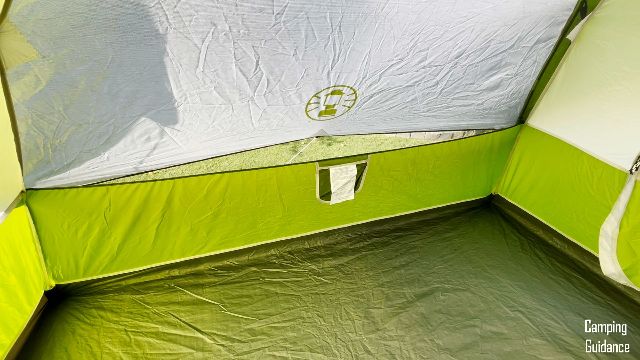
There’s also this small ground vent, so 3 vents altogether. On top of that, I could crack the 2 windows open if the wind isn’t too heavy, thanks to the slightly overhanging rainfly pole.
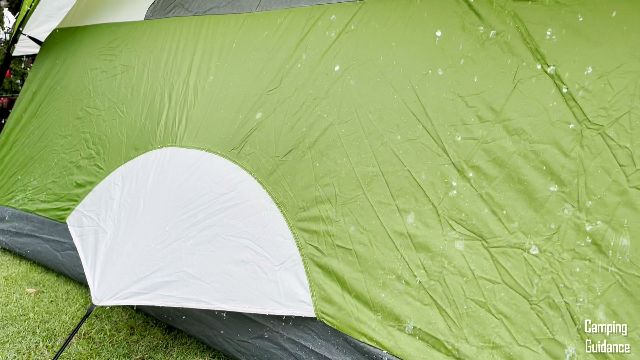
The Caddis Rapid 6 has 3 big window vents, but these are smaller than the Sundome’s. Also, I could crack the front window open in the light wind.

The Wawona 6 has 2 window vents, and it also has 2 of these smaller vents.
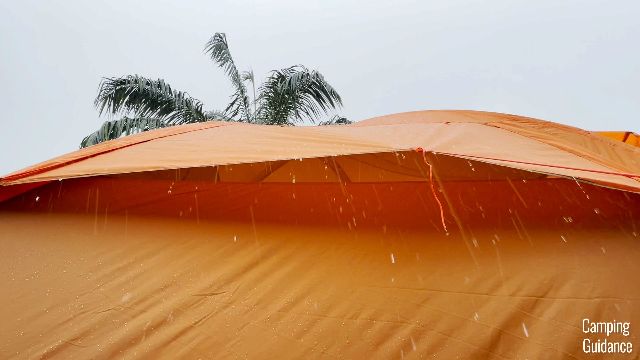
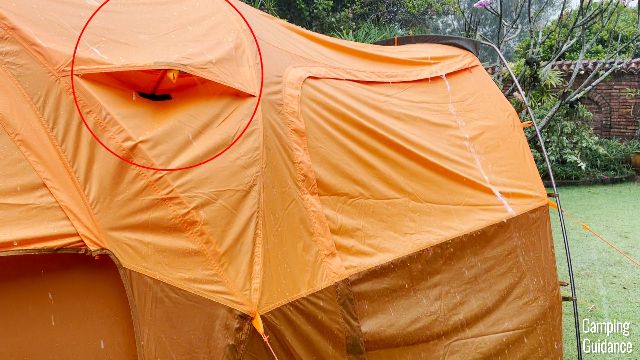
Notice that the vents are getting smaller and smaller as we move from tent to tent, so that’s how I kind of eyeballed and rated each tent for rainy day ventilation.
The Base Camp 6 has 2 roof vents, and 2 floor vents, and these were the only vents that I could open and shut from the inside of the tent.

After that, we’ve got the Wonderland 6, with just these 2 windows that I could crack open, thanks to the awnings on the outside.
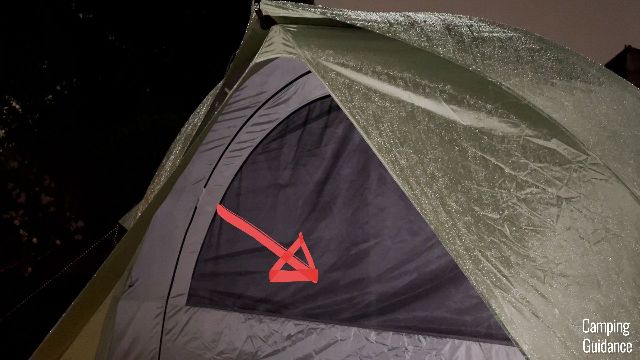
There’s also 2 of these above door vents, but they’re so small they didn’t even do very much. I didn’t even consider them to be ‘vents’.
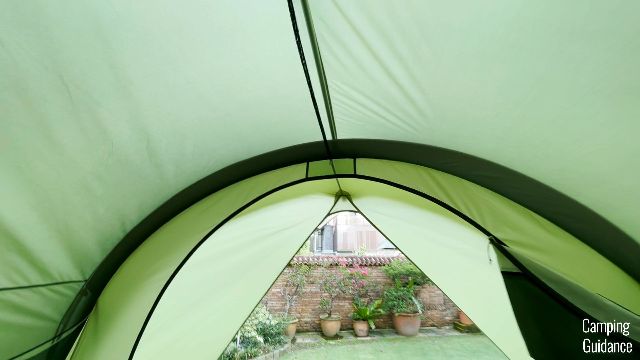
The Cherokee has only 2 small mesh wall vents, while the Eureka has no vents at all, and only the front window could be cracked open slightly.
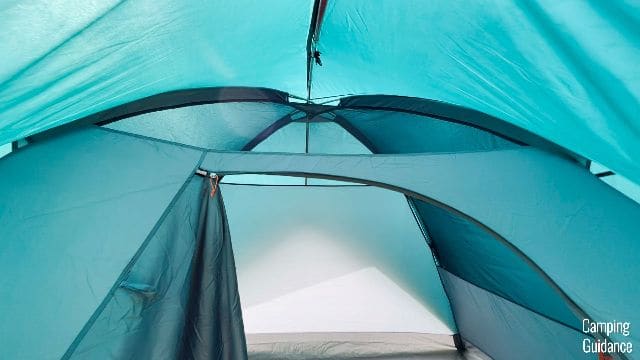
Ventilation Ratings
And here’s how I rated each 6-person tent for ventilation:
| 6-Person Tent | Ventilation Ratings |
|---|---|
| Caddis Rapid 6 | 8.3 |
| REI Wonderland 6 | 7.5 |
| Coleman Sundome 6 | 7.5 |
| The North Face Wawona 6 | 7.0 |
| REI Base Camp 6 | 6.0 |
| Eureka Copper Canyon LX 6 | 6.0 |
| NTK Cherokee 6 | 5.5 |
5. Weather Protection
For weather protection, I’m going to look at both rain and wind.
Heavy Rain Test
For heavy rain, I put each 6-person tent through a pretty brutal 1-hour rain test, and here are the (unfortunate) results:
| 6-Person Tent | Heavy Rain (1 Hour) |
|---|---|
| The North Face Wawona 6 | Passed |
| REI Base Camp 6 | Passed |
| REI Wonderland 6 | Failed |
| Eureka Copper Canyon LX 6 | Failed |
| Caddis Rapid 6 | Failed |
| Coleman Sundome 6 | Failed |
| NTK Cherokee 6 | Failed |
First up, and hats off to the Wawona 6, I put this tent through not 1 hour, but 3 hours of pouring rain, plus flooding, and this tent still passed with flying colors.
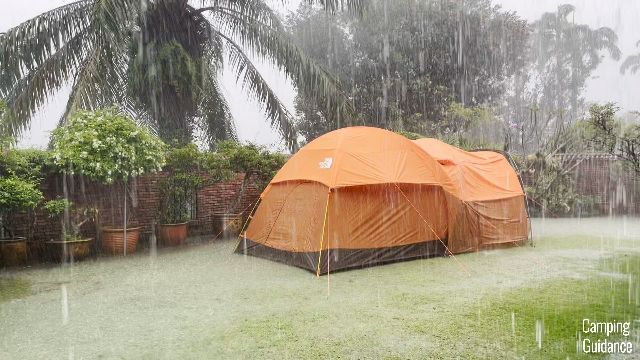

The Base Camp 6 went through a 1-hour hose test, which is much heavier than your average rain, and it stayed completely dry as well, thanks to this full-length rainfly:

However, it’s not as great as the Wawona because of the flooring seams, which I found, were not taped. They were only inverted.
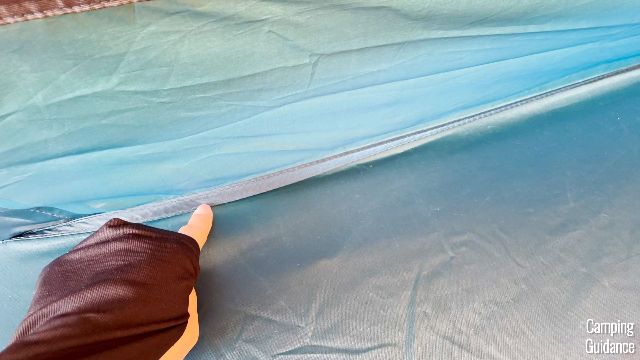
So, when I sprayed water directly onto the tent body (not the rainfly), which dripped down to these seams, it leaked after an hour. It wouldn’t have survived the Wawona’s flooding test for sure.

The next 3 tents had a little bit of leakage after the 1-hour heavy rain test. For the Wonderland, it was the seams of the divider loops (the only seams that were not taped/sealed) at the bottom:
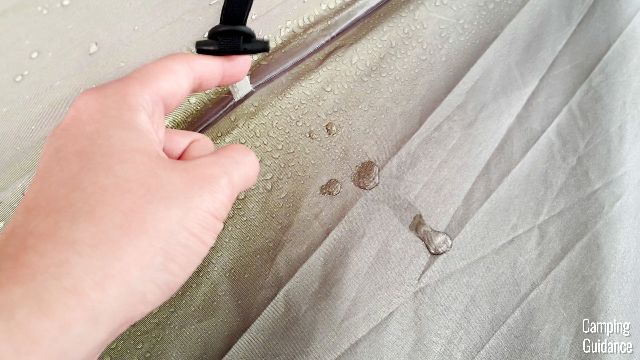
For the Eureka, it was the vertical seams, and for the Caddis Rapid, it was the corners seams.
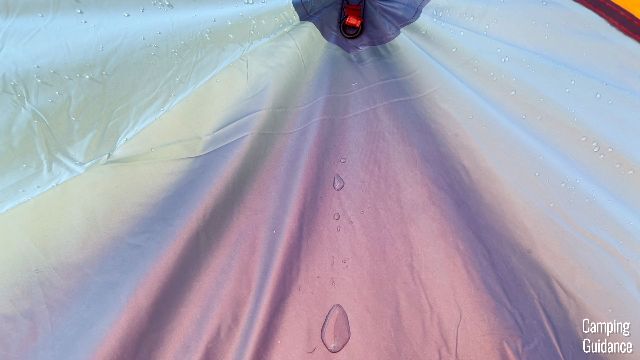
Pro Tip #4: Essentially, I think cabin tents aren’t as waterproof, because the rainfly is much smaller, so more water runs over the tent body and into the seams.
The last 2 more budget-friendly tents started leaking after about 35 to 40 minutes.
Pro Tip #5: And that’s because the seam taping in budget tents are usually always lacking.
Wind Protection
And as for wind protection, I’m gonna be honest, I don’t usually camp in strong wind, so I didn’t do quite as thorough a wind test, but here’s a few things that I learned.
First, cabin tents are definitely not great in wind, because of their vertical side walls. In fact, my Eureka blew over in a light breeze the moment I removed the stakes to take down the tent.
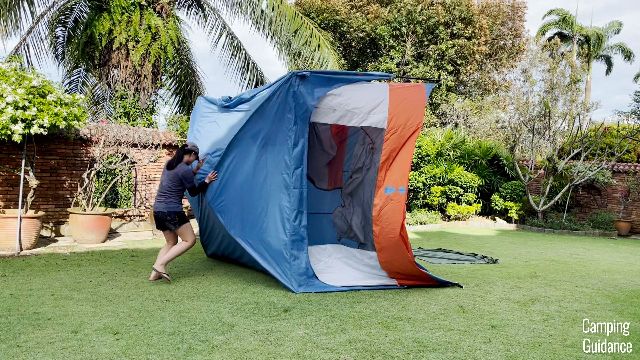
On the other hand, I was able to test my Wawona 6 in slightly more moderate winds of about 10-15, maybe even 20 miles per hour, and it held up like a champ.
Also, the more guylines your tent has, the better it’ll do in wind. So, when I was testing my Wawona, it really helped that I had almost the entire tent guyed out.
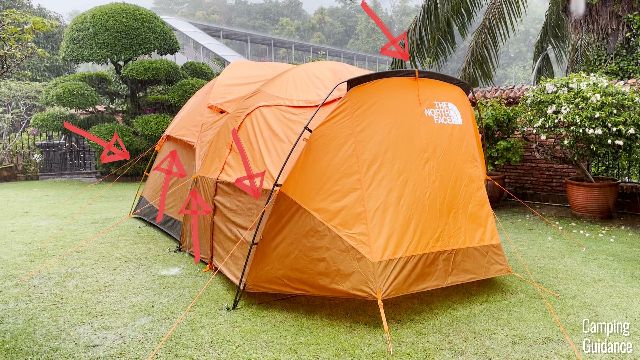
Here’s basically a quick summary of what I just explained, and I listed what I think is the best tent in heavy wind, to the not-so-good tents in heavy wind:
| 6-Person Tent | Tent Shape | Guylines |
|---|---|---|
| The North Face Wawona 6 | Dome | 11 |
| REI Base Camp 6 | Dome | 6 |
| Coleman Sundome 6 | Dome | 6 |
| NTK Cherokee 6 | Dome | 4 |
| REI Wonderland 6 | Cabin | 14 |
| Eureka Copper Canyon LX 6 | Cabin | 8 |
| Caddis Rapid 6 | Cabin | 7 |
There’s actually another point I need to mention, which is pole quality, and I’ll go through that in just a few minutes.
Weather Protection Ratings
For now, here’s how I rated each 6-person tent for weather protection:
| 6-Person Tent | Weather Protection Ratings |
|---|---|
| The North Face Wawona 6 | 9.7 |
| REI Base Camp 6 | 8.7 |
| REI Wonderland 6 | 6.7 |
| Caddis Rapid 6 | 5.4 |
| Eureka Copper Canyon LX 6 | 5.4 |
| Coleman Sundome 6 | 4.9 |
| NTK Cherokee 6 | 4.9 |
6. Quality
For quality, I looked at the flooring, the tent body, the poles, zippers, mesh, seam quality and seam taping.
Flooring Quality
Let’s start with the flooring, and here’s a quick summary of the flooring material in each tent, starting from the best:
| 6-Person Tent | Flooring Material |
|---|---|
| Caddis Rapid 6 | 210D Polyester |
| The North Face Wawona 6 | 150D Polyester |
| REI Base Camp 6 | 150D Polyester |
| REI Wonderland 6 | 150D Polyester |
| Eureka Copper Canyon LX 6 | 75D Polyester |
| Coleman Sundome 6 | Polyethylene |
| NTK Cherokee 6 | Polyethylene |
Generally, I’ve found that higher-end camping tents tend to have much thicker floorings, at least of 150-denier polyester.
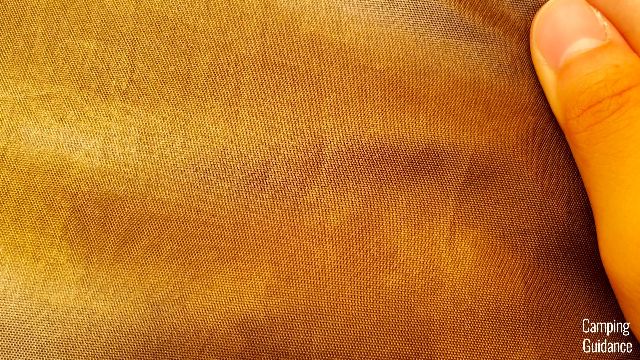
I’m honestly a little surprised that Eureka chose to have only a 75-denier polyester flooring, which is half as thick.
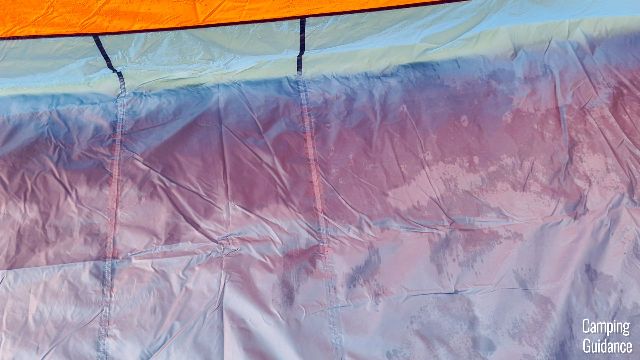
On the other hand, more budget tents like Coleman and NTK are usually made of less-expensive polyethylene.

Tent Body Quality
Moving onto the material of the rest of the tent, here’s another quick summary for you:
| 6-Person Tent | Tent Body & Rainfly Material |
|---|---|
| Caddis Rapid 6 | 190D Polyester |
| The North Face Wawona 6 | 75D Polyester |
| REI Base Camp 6 | 75D Polyester |
| REI Wonderland 6 | 75D Polyester |
| Eureka Copper Canyon LX 6 | 75D Polyester |
| Coleman Sundome 6 | 68-75D Polyester |
| NTK Cherokee 6 | 68D Polyester |
Honestly, I’m pretty surprised at the thickness of the flooring and the tent body in the Caddis Rapid 6. It’s actually a lot thicker than even the more expensive tents on this list.
Apart from the Caddis Rapid, the tent body and rainfly of better quality tents tend to be made of at least 75-denier polyester:
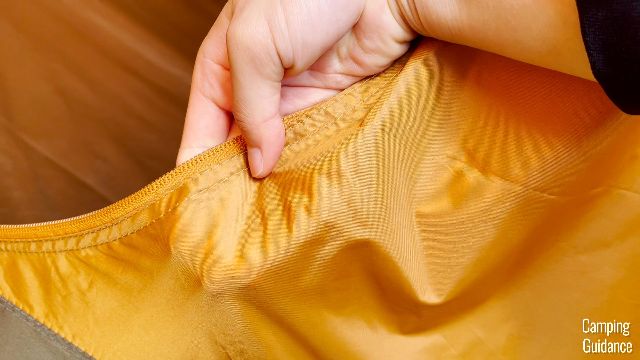
On the other hand, budget tents are made of 68-denier polyester. Coleman is a little better than NTK, because some of their rainflies are made of 75D polyester, while NTK is 68D all around (for both the rainfly and tent body).
Pole Quality
As for the quality of the poles, here’s a quick run-down for you.
| 6-Person Tent | Material of Poles |
|---|---|
| The North Face Wawona 6 | DAC MX |
| REI Base Camp 6 | Aluminum |
| REI Wonderland 6 | Aluminum |
| Caddis Rapid 6 | Steel |
| Eureka Copper Canyon LX 6 | Steel & Fiberglass |
| Coleman Sundome 6 | Fiberglass |
| NTK Cherokee 6 | Fiberglass |
Easily the best quality poles are the Wawona’s, which is DAC MX, top-of-the-line type of aluminum poles. These poles not only snap together super easily, but they’re also a lot stronger than regular aluminum poles.
In the weeks that I spent testing my Wawona 6, through crazy rains and some winds, none of my poles bent at all.

Next up, we have the 2 REI tents, with just regular aluminum poles, which are not as strong. So, for my Wonderland 6, I found that a few of my poles bent after some use.

And here’s how pole quality affects the wind resistance of each tent:
| 6-Person Tent | Tent Shape | Guylines | Poles |
|---|---|---|---|
| The North Face Wawona 6 | Dome | 11 | DAC MX |
| REI Base Camp 6 | Dome | 6 | Aluminum |
| Coleman Sundome 6 | Dome | 6 | Fiberglass |
| NTK Cherokee 6 | Dome | 4 | Fiberglass |
| REI Wonderland 6 | Cabin | 14 | Aluminum |
| Eureka Copper Canyon LX 6 | Cabin | 8 | Steel & Fiberglass |
| Caddis Rapid 6 | Cabin | 7 | Steel |
Basically, DAC MX will always trump regular aluminum. A friend of mine used his Wawona 6 through 50 mile per hour winds, and here’s the state of the poles after. Notice the slight bend in them:

Honestly, still not too bad, and not even as bent as my Wonderland poles, which didn’t even go through a strong wind test.
Zipper Quality
As for the quality of the zippers, here’s what you’ll find in each 6-person tent:
| 6-Person Tent | Brand of Zippers |
|---|---|
| REI Base Camp 6 | YKK (*Doors only) |
| REI Wonderland 6 | YKK (*Doors only) |
| The North Face Wawona 6 | SBS |
| Eureka Copper Canyon LX 6 | SBS |
| Caddis Rapid 6 | No brand |
| Coleman Sundome 6 | No brand |
| NTK Cherokee 6 | No brand |
Only my REI tents came with YKK zippers, but somehow only the doors have YKK zippers. The windows have no-brand zippers.

The Wawona and Eureka have SBS zippers, so a grade lower than YKK, but still pretty good quality. And the plus side is that both the doors and the windows are SBS.

I’m a little surprised that the Caddis Rapid 6 skimped on the zippers, when the rest of the tent is pretty high quality. No brand zippers are usually what I find on more budget tents instead.
Mesh Quality
As for the quality of the mesh that you’ll find in each tent, here are the details:
| 6-Person Tent | Mesh Quality |
|---|---|
| REI Base Camp 6 | Micro mesh |
| REI Wonderland 6 | Micro mesh |
| Eureka Copper Canyon LX 6 | Micro mesh |
| The North Face Wawona 6 | Micro mesh |
| Caddis Rapid 6 | Micro mesh |
| Coleman Sundome 6 | Regular mesh |
| NTK Cherokee 6 | Regular mesh |
Again, you can see quite a big difference between the more premium tents, and the budget tents.
I wrote down ‘micro mesh’ for the first 5 tents, because none of these brands specifically say that their mesh is ‘no-see-um’ mesh, although it feels like it to me, and the holes look really fine too.
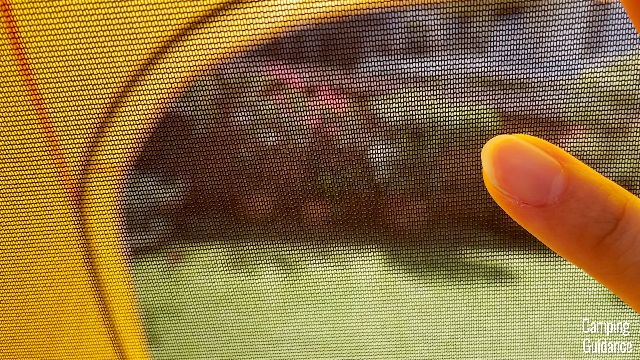
The mesh on my budget tents have much bigger holes. This is more like regular mosquito netting:
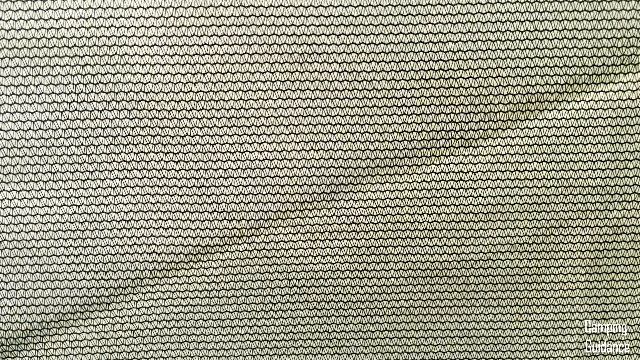
Seam Quality
For the seam quality in each tent, I found that the more premium tents tend to not have many loose threads, they’re all nicely reinforced, especially at the corners as well as the rest of the flooring, and the stitching is nice and consistent.

On the other hand, the more budget-friendly tents tend to have more loose threads, slightly less consistent stitching, and some holes in the seams can be a little larger than others.
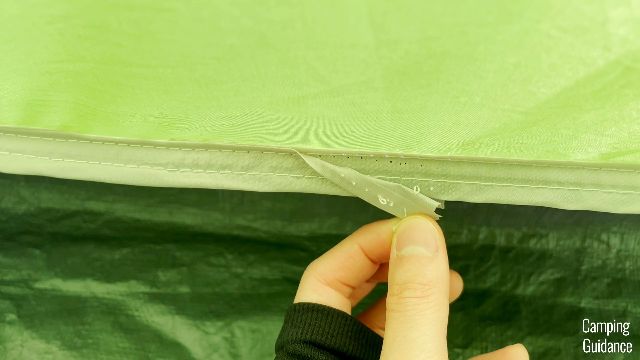
Seam Taping
As for seam taping, the pricier tents tend to have much better seam taping, while budget tents are usually really lacking in this department.
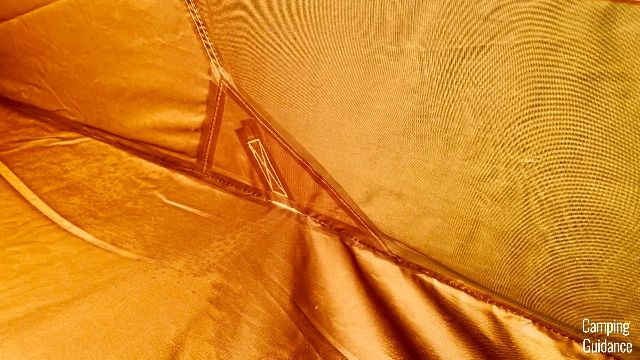
Quality Ratings
So, here’s how I rated all the tents based on quality:
| 6-Person Tent | Quality Ratings |
|---|---|
| The North Face Wawona 6 | 9.3 |
| REI Base Camp 6 | 9.0 |
| REI Wonderland 6 | 8.7 |
| Caddis Rapid 6 | 8.7 |
| Eureka Copper Canyon LX 6 | 8.2 |
| Coleman Sundome 6 | 6.3 |
| NTK Cherokee 6 | 6.2 |
7. Portability
For portability, I looked at 2 main things:
- Weight; and
- Packed size.
Weight
Here’s the weight of each 6-person tent on this list, from the heaviest to the lightest:
| 6-Person Tent | Weight |
|---|---|
| Caddis Rapid 6 | 25.0lbs. |
| REI Wonderland 6 | 23.6lbs. |
| Eureka Copper Canyon LX 6 | 22.4lbs. |
| REI Base Camp 6 | 20.6lbs. |
| The North Face Wawona 6 | 19.4lbs. |
| Coleman Sundome 6 | 16.0lbs. |
| NTK Cherokee 6 | 15.2lbs. |
Pro Tip #6: In general, higher quality camping (not backpacking) tents tend to be a little heavier than budget camping tents.
This is because thicker materials usually means more weight. Also, steel and aluminum poles are heavier than lower-quality fiberglass, so again, more weight.
This is just the general rule, though there are exceptions to the rule. For example, DAC MX is actually more lightweight than regular aluminum.
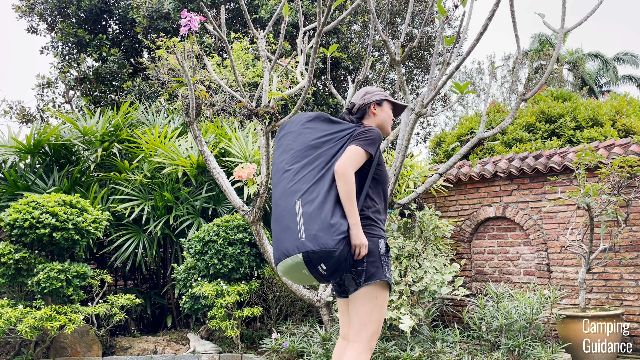
Packed Size
And here’s the packed size of each 6-person tent, from the biggest to the smallest:
| 6-Person Tent | Packed Size |
|---|---|
| Caddis Rapid 6 | 50 x 15 x 9.5 inches |
| REI Wonderland 6 | 30 x 15 x 10 inches |
| The North Face Wawona 6 | 26 x 16 x 10 inches |
| REI Base Camp 6 | 28 x 13 x 9.5 inches |
| Eureka Copper Canyon LX 6 | 29 x 13 x 9 inches |
| Coleman Sundome 6 | 27 x 12 x 9.5 inches |
| NTK Cherokee 6 | 26 x 12 x 8.5 inches |
Take note here that instant tents tend to be much longer than regular tents. For example, the Caddis Rapid 6 is 40% longer than any other regular 6-person cabin tent.
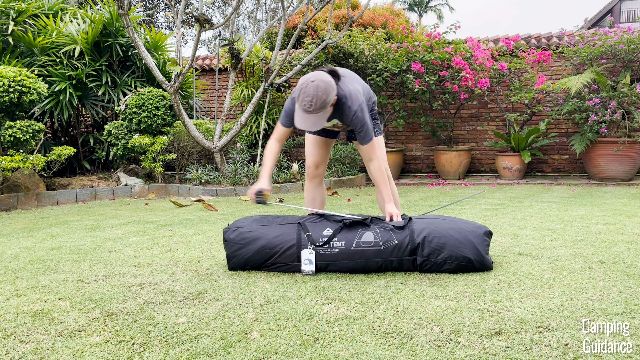
Portability Ratings
And based on the weight and packed size, here’s how I rated each of these 6-person tents:
| 6-Person Tent | Portability Ratings |
|---|---|
| NTK Cherokee 6 | 10.0 |
| Coleman Sundome 6 | 9.5 |
| REI Base Camp 6 | 8.0 |
| The North Face Wawona 6 | 7.5 |
| Eureka Copper Canyon LX 6 | 7.5 |
| REI Wonderland 6 | 6.0 |
| Caddis Rapid 6 | 3.0 |
Why You Can Trust Me
Unlike most 6-person tent reviews (especially these “Best 6-Person Tents” reviews) that you find on the internet, I actually own, used and thoroughly tested all of these tents.
In fact, I spent a total of $2,110 buying these seven 6-person tents (I blew my budget of $2K!), and a good 6 months testing all of them, not including the time it took to put together this series of articles and YouTube videos.
Because I’m dedicated to giving you the very best information you can possibly find on these tents.
Conclusion
I hope this guide has helped you to find the 6-person tent that best suits your need. Here’s a quick summary:
- Best Overall: The North Face Wawona 6
- Best for Rain: The North Face Wawona 6
- Best for Summer: The North Face Wawona 6
- Best Value for Money: The North Face Wawona 6
- Runner-Up Pick: REI Base Camp 6
- Best for Colder Weather: REI Base Camp 6
- Best Cabin Tent: REI Wonderland 6
- Best for Hot Weather: REI Wonderland 6
- Runner-Up Cabin Tent: Caddis Rapid 6 or Eureka Copper Canyon LX 6
- Easiest to Set Up: Caddis Rapid 6
- Highest Peak Height: Eureka Copper Canyon LX 6
- Best Budget Pick: Coleman Sundome 6
- Alternative Budget Pick: NTK Cherokee 6
If you need more help, feel free to shoot me an email (you can find it in my ‘Contact Me’ page). Do address it to ‘Liz’, because that’s how I sieve out spam mail. I’ll be more than happy to help you out!



